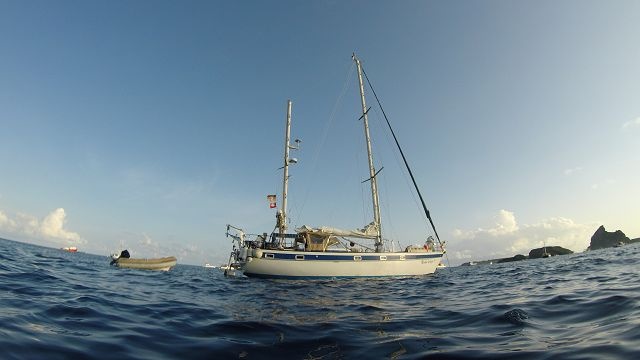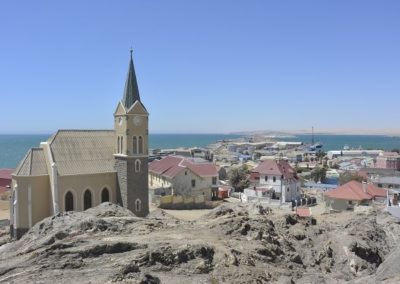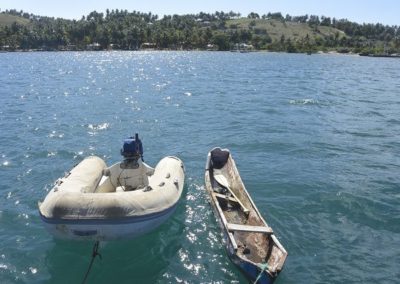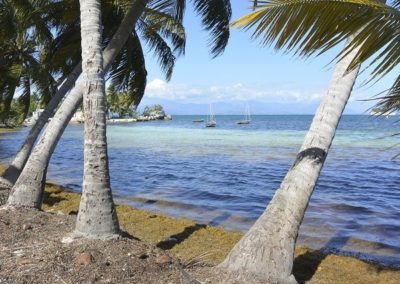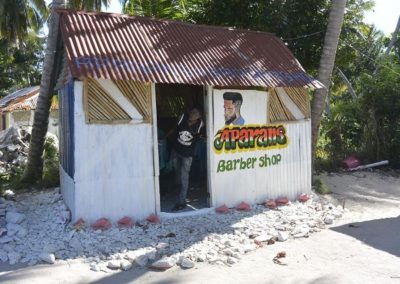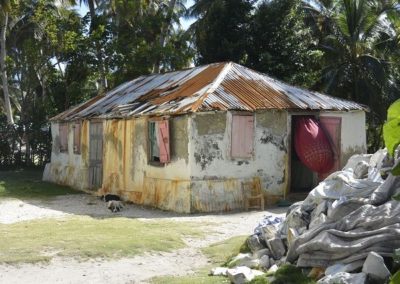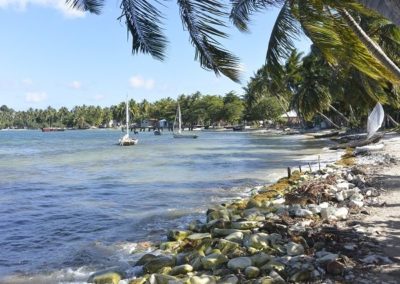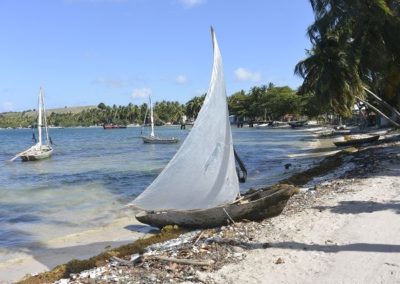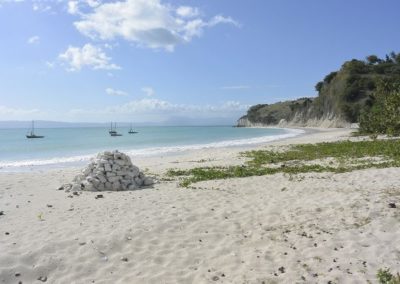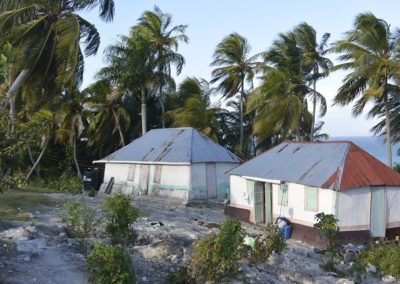Atlantic Crossing
Blauwasser – Segeln
English version see below.
Total Kilometer: 34’734 Kilometer
Totalzeit auf dem Rad: 2065 h
Land Kilometer: – Kilometer
Seemeilen: 6823 Seemeilen/Nautische Meilen (1 Sm = 1.85 Kilometer)
Tage: 78 Tage
1) Kapstadt – Lüderitz 480 Sm
2) Lüderitz – Walvis Bay 250 Sm
3) Walvis Bay – St. Helena 1234 Sm
4) St. Helena – Fernando de Noronha 1740 Sm
5) Fernando de Noronha – Ile de Diable 1334 Sm
6) Ile de Diable – Grenada 700 Sm
7) Grenada – Kuba 1085 Sm
Von Kapstadt nach Lüderitz
Nun, nach einer elf monatigen Vorfreude ist es endlich soweit. Mein neustes ausgeflippte Abenteuer steht vor der Tür. Die letzte Nacht auf Land verbrachte ich bei einem der besten Gastgebern, David, den ich herzlich verabschiede. Mit meinem ganzen Gehabe fahre ich zur Marina, die streng bewacht ist. Durch Freunde des Skippers gelange ich auf den Steg, wo mir dann schon Jens, der Skipper und der Matrose Kevin entgegen kommen. Im Restaurant trinken wir freudig auf unsere gemeinsame Zeit auf dem Segelschiff Nuku Alofa.
Ich kann mich gar nicht erst auf dem Schiff einleben, schon gehts am nächsten Morgen nach einem feinen Frühstück, zubereitet von Kevin, los aufs offene Meer. Jens lässt einem Tanker, gelotst von Schleppbooten, die Vorfahrt und schon tuckern wir hinaus aus der grossen Marina. Hinter uns sehen wir noch lange den Tafelberg, das Wahrzeichen von Kapstadt. Die touristische Robben Island, wo früher Nelson Mandela gefangen gehalten wurde schwimmt links von uns vorbei. Wir machen richtig Fahrt, als wir das erste Mal die Segel setzen. Genauer gesagt ist es für mich das erste Mal, doch für Jens das X. Mal, denn er startete seinen Segel-Weltumsegelung am 1. August 2018 (eigentlich das 2. Mal, weil nach drei Tagen kamen sie schon in einen heftigen Sturm, sodass sie wegen grösseren Schäden am Schiff umkehren mussten) in Thailand.
Nach einem Mittagschläfchen (die Abschiedsparty in Kapstadt war lang und anstrengend), erzählen die anderen von springenden Walen. Gespannt halte ich Ausschau nach mehr. Plötzlich tauchen etwa sechs Buckelwale nahe auf der Backbordseite auf und bliesen ihre Fontäne in die Luft. Sie schwimmen direkt auf uns zu. Wenn das nur gut geht! In einem Zeitungsartikel in Mosselbay sah ich ein total beschädigtes Segelschiff, nachdem ein Wal aufs Schiff plumpste. Fünf Meter vor uns tauchen zwei ab und dann Rumms. Einer hat tatsächlich unser Boot gerammt. Ob der Wal uns nicht gesehen hat oder er unseren Tiefgang von 2.10 Meter nicht einschätzen konnte? Kurze Zeit später kommt ein freudig springender Wal näher. Doch zum Glück wechselt er seine Richtung. Er ist so gross wie ein Bus. Video eines springenden Wales: GOPR1403
Da wir 24 Stunden segeln teilen wir die Nacht in drei Schichten von vier Stunden ein. Die erste übernehme ich. Jens bleibt die ersten zwei Stunden bei mir und erklärt was zu tun ist. Falls der Wind dreht, muss ich das Steuer in die entsprechende Richtung drehen. Auf dem AIS (Automatic Identified System) muss ich nach Schiffen und auf Unebenheiten achten und probieren nicht einzuschlafen. In der letzten Stunde gerate ich auf einmal zu sehr auf Steuerseite und stehe somit im Wind. Ich drehe und drehe am Steuerrad, aber das Boot lässt sich nicht wenden. So rufe ich Jens. Er schläft noch nicht, so hört er mich sofort. Die letzten Minuten steuere ich das Boot von Hand. Müdig falle ich ins Bett.
In den Nächten ist es ein besonderes Gefühl das Boot zu steuern. Meine Mitseglern schlafen, während ich mich für vier Stunden auf den von mir programmierten Kurs konzentriere. Man ist alleine, alleine steuere ich das dreizehn Meter lange Segelschiff, es ist unter meiner Kontrolle, ich könnte auch direkt Brasilien ansteuern, was dem Jens aber nicht gefallen würde. Der Mond füllt sich langsam, die Sternen leuchten weniger. Ausserhalb der Plicht wage ich nicht zu gehen, es ist kalt, windig (zum Glück) und stockdunkel. Ohne Rettungsweste ist es nicht ratsam auf dem Deck herum zu laufen, auch wenn man mal muss. Froh bin ich, als Kevin mich ablöste, so sause ich schnell auf die Toilette und ins Bett, um mich aufzuwärmen. Am nächsten Morgen frühstücken wir gemeinsam, eine Seltenheit beim Segeln. Sie halten gerade Ausschau nach zwei Schiffen, welche das AIS uns angibt. Mit meinen Adleraugen, wie der Vollmatrose auf der Maersk Alabama, sehe ich gleich eines. Kevin das andere. Beides riesengrosse Containerschiffe.
Ich hantiere mit der Fischrute, da meint Jens er hole einen neuen Köder. Der Alte ist schwul, weil er die Farbe pink hat und ist ausgefranst von der starken Strömung oder von knabbernden Fischen. Zurück in der Koje genehmige ich ein Nickerchen. Als ich wenig später aus der Dachluke schaue, sehe ich schon einen grossen Fisch filettiert in einer Schüssel. Und dann noch ein Bigeye Tuna. Nanu, haben die alle Hunger so wie wir wieder? Nach zwei Tagen auf See gewöhnte unser Körper an das Schaukeln. Ich glaube allen drei war es schlummrig, keiner hat etwas kochen wollen. Tabletten gegen Seekrankheit habe ich auf der ganzen Schiffsreise nie genommen. Am Abend koche ich Kartoffel, Karotten und Fisch. Sehr lecker!
Bei einer weiteren Wachablösung willkommt Jens mich zu Namibia. So hänge ich die namibische Flagge rauf, rechts des Grossmasts und salutierte.
In der Nähe von Oranjemund wo auch der grosse Orange Fluss von Südafrika ins Meer fliesst hat es Null Wind. So nehmen wir alle Segel runter, weil das Geklappere Kevin nervt. Ich ziehe mich aus und hüpfe ins Wasser. Brrr, ist das kalt. Schwimme um das Boot herum, die anderen folgen mir. Auf dem AIS sehen wir viele Boote, aber von Auge sehen wir nichts dergleichen. So klettere ich bewaffnet mit Fernglas und GoPro Kamera am Mast des Grossbaumes hoch, gesichert von Jens. Herrlich, die Sicht ist entzückend. Nur Himmel und Wasser, mehr blau als was anderes. Unter mir sieht das Segelschiff winzig aus. Die Fischerboote sehe ich auch von hier oben nicht.
Jens, der Skipper, dem auch die Nuku Alofa gehört wohnt in Frankfurt an der Oder, welches ein Grenzfluss zu Polen ist. Er ist Anwalt, hat eine eigene Kanzlei mit vielen Angestellten. Zusätzlich besitzt er eine Marina und probiert sich im Baugeschäft ein sogenanntes Haus-Facility.
Kevin kommt aus Nürnberg, wohnt jetzt in Köln und hat eine hübsche Polizistin als Freundin, die schmerzlich Heimweh hat. Kevin hat einige Fotos oberhalb seiner Koje hängen und es wird jeden Sonntag eins mehr, denn sein Liebling hat ihm mehr als dreissig Briefe vorgeschrieben. Was für eine Liebe! Er selber arbeitet als Wirtschaftsprüfer, prüft verschiedene Banken.
Kurz vor Lüderitz sehen wir vermehrt Robben, die auf dem Rücken sich sonnen, wahrscheinlich um eine Pause einzulegen, müde vom Fischchen fangen. Auch sehen wir einige Pinguine, die herum plantschen. Das absolute Highlight des Tages sind die Delfine. Sie lieben es vor und neben dem Bug des Schiffes mitzuschwimmen.
-
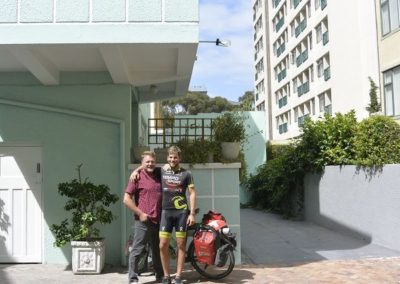
My best host in Capetown
-
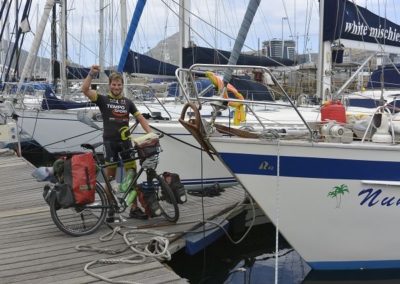
My bicycle goes on the sailing ship
-
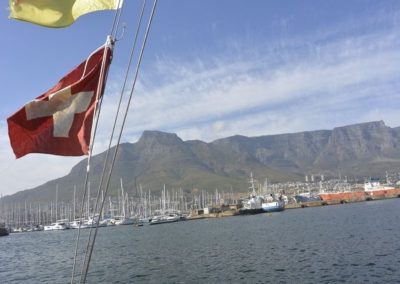
Leaving South Africa with its Tabel Mountain
-
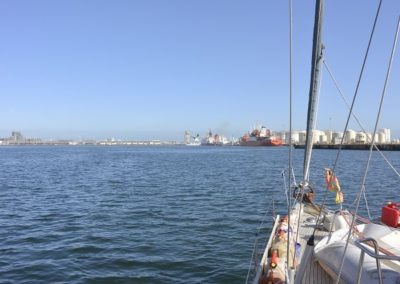
Leaving the harbour
-
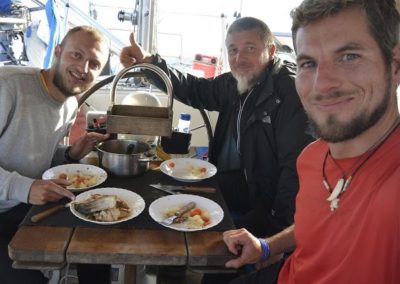
Together the next 80 days
-
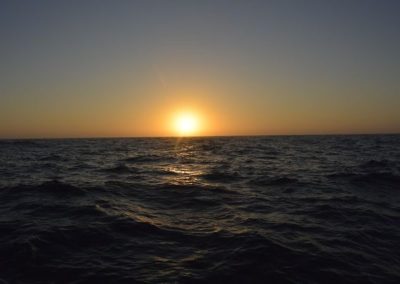
Sunset
Lüderitz
Lüderitz ist ein kleines Städtchen inmitten der Naukluft Wüste, das absolutes Sperrgebiet für alle Leute ist. Obwohl die Diamantenzeit mehr oder weniger vorüber ist.
Da und dort graben sie noch. Aber die Blütezeit ist definitiv vorbei. Ein gutes Beispiel ist die Geisterstadt Kolmanskuppe. Die besuchen wir am nächsten Tag. Sehr informativ und spannend zu zuhören, wie sie früher besser gelebt haben als wir heute in Europa. Zurück auf dem Boot bereiten wir uns auf die nächste Etappe vor. Die Wasserkanister, Wassertanks (700l) und Dieseltank vom Boot müssen gefüllt werden. Im Supermarkt proviantieren wir uns durch die Regale. Nicht einmal Risotto haben sie, ich ärgere mich, denn das ist meine Spezialität.
Von Lüderitz nach Walvis Bay
Bei Starkwind von Windspitzen bis zu zweiundvierzig Knoten legen wir ab. Wir setzen die Segel erst als wir ein gutes Stück weg von der Küste sind. Etwa nach elf Uhr morgens ist die Wüste so stark aufgeheizt, sodass ein starker Wind sich aufbaut, durch Lüderitz fegt und dann hinaus aufs offene Meer.
Wieder muss ich meine Füsse um das Steuerrohr legen, welches durch unsere Koje verläuft. Kevin, mit dem ich unser Schlafgemach teile, genehmigt mir freundschaftlich diese Schlafposition, weil dann meine Füsse ein wenig auf seiner Matratze ruhen. Ich habe ihm mitgeteilt, dass ich Angst habe, wieder aus dem Bett zu fallen, wenn das Boot wieder wegen einer Welle in starke Seitenlage kippt.
Bei meiner Nachtwache stürmt plötzlich Kevin zur Brücke (Kommandozentrale des Schiffes) und ruft aufgebracht: „Wo bist du?“
„Hier bin ich“, antwortete ich.
„Ich hatte Angst, weil ich dich nicht im Bett gesehen habe.“
Ein lustiger Kerl. Er löste mich diesmal pünktlich ab. In Lüderitz lud er mich zu einem Drink ein, weil er einmal zu spät zur Wache erschien. Schlafen konnte ich wieder nicht. Dieses Wiegen bewegt ständig mein Kopf, im Ohr herrscht dann ein Geräusch (so ein Gekratze vom Kissen), das nicht schlafbar macht. Ein bewegender Körper kann nicht ruhn. Ich höre wie Kevin ins Badezimmer geht. Plötzlisch knallt die Tür mit einem lauten Knall auf und Kevin, der anscheinend das Gleichgewicht verloren hat, schiesst hinaus. Er taumelt und stöhnt dabei. „Alles in Ordnung?“ „Jaja.“ Er versucht es nochmals.
Am Morgen begrüssen uns gegen fünfzig Seelöwen beim Frühstück.
Die erste Packung Pasta schmeisse ich über Bord mitsamt den Käfern drin. Doch das Hackfleisch mit Paprikaschote und Pasta (ohne Käfer) schmeckt allen.
Beim Segeln bewegt man sich nicht wirklich sportlich, darum verstehe ich nicht ganz warum das Segeln eine Sporart ist. Vorgesorgt habe ich, indem ich eine Yogamatte in Kapstadt organisiert habe. Auf der mache ich fast jeden Tag meine Kraftübungen mit Hilfe eines Workout-App. Je nach Wellengang mache ich dies im Salon oder auf Deck an der Sonne. Komisch, warum ist die Angelrute so stark gebogen? Ein Fisch! Und was für ein Exemplar, wieder ein Bigeye Tuna (eine Art Thunfisch). Auf bestialische Weise töten sie ihn. Kevin präpariert ihn fürs Abendessen und ein Teil zum Trocknen.
Nach einem Nickerchen schon wieder einer. Mensch, die müssen hier kein Futter finden können. Ich halte den etwa drei Kilogramm schweren und sehr glitschigen Körper mit Handschuhen fest, Jens holt mit grossem Schwung mit dem Schraubendreher zum Totschlag aus. „Halt!“, rufe ich. „Wollt ihr den wirklich essen? Wir haben schon einen genug Grossen fürs Abendessen. Und dieser ist etwa doppelt so gross. Lasst ihn am Leben.“ Gesagt, getan. Ich werfe den Glücklichen erleichtert zurück ins Meer. Dummerweise übersehe ich die eine Eisenstange. So fällt er auf diese, dann auf die Badeplattform, bevor er ins Nasse hechtete. Er wird ein paar Blessuren davon tragen.
In der Bucht vor Walvis Bay ist so richtig was los was den Schiffsverkehr betrifft. Walvis Bay ist der einzige Versorgungshafen von Namibia, auch für Botsuana, das ein Binnenland ist. Wir müssen um einige Schiffe herum manövrieren, bevor wir wieder wie in Lüderitz vor Anker gehen. Da es kein Steg hat, lassen wir unser Beiboot, das Dingi, zu Wasser, hüpfen rein und losen aus, wer als erster unter die lang ersehnte Dusche hüpfen darf, falls es nur eine hat. Als nächstes per WiFi unseren Lieben zu Hause schreiben, dass wir wieder ein Stück weiter sind. An diesem Ort machen wir alles was wir in Lüderitz gemacht haben umgekehrt. Also beim Immigration Büro den Ausreisestempel holen, bei der Hafenbehörde das Boot ausklarieren und allen Namibianern auf Wiedersehen zuzurufen und mit Nastüchern winken. Meine Motivation ist momentan im Keller, denn ich konnte zwar mein Sack, den ich hier deponiert habe abholen, aber ich konnte keinen einzigen Fallschirmsprung in Swakopmund machen, wegen Weihnachten und Nebel. Weihnachten feiern wir mit einer anderen Crew (Oroborro) in einem Restaurant. Es sind zwei Pärchen auf dem Weg nach Rio de Janeiro in Brasilien. Kevin verliebte sich prompt in die Japanerin. Die anderen sind von Portugal, und USA.
-
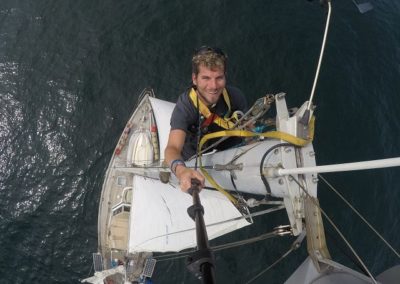
Me and the tiny boat
-
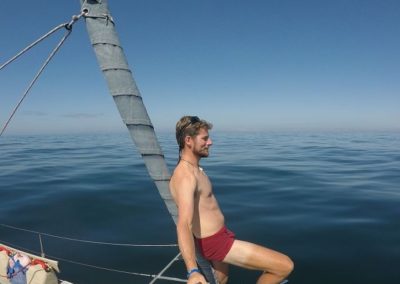
Feeling the fresh air
-
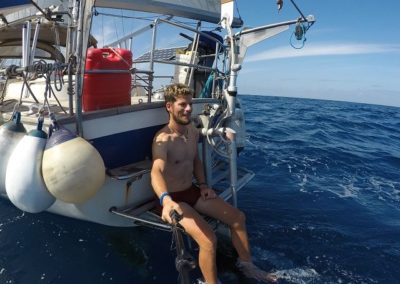
Chilling
-
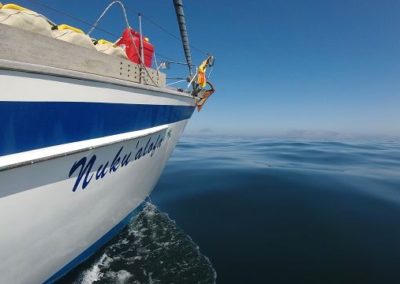
Nuku Alofa
-

Marvellous
-
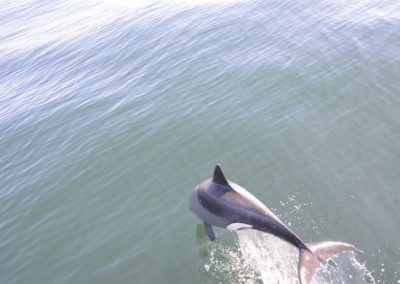
Dolphins
-
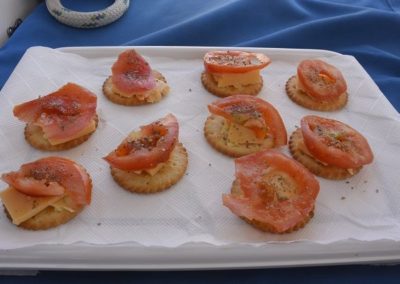
Aperitiv
-
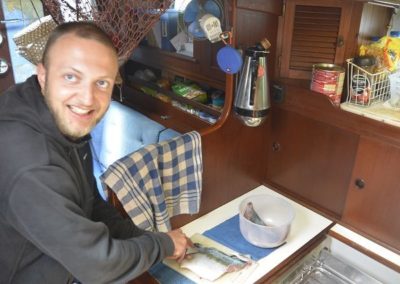
Filleting the....
-
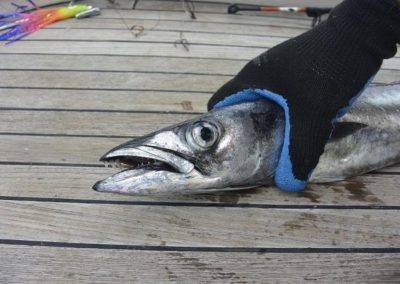
...Big Eye Tuna
Walvis Bay nach St. Helena
Am 25. Dezember 2018 um 15.30 starten wir unser langes Abenteuer über den Atlantik. Nachdem wir den Bohrturm passiert haben, setzen wir das Gross und die Genua Steuerbordseitig. Der Wind weht mit 15 bis 20 Knoten, das macht eine Geschwindigkeit von 5 Knoten, dann 6 Kn. Nach einer Stunde weht es kräftiger aus Südost, was uns auf 7.5 Knoten bringt. Ich sage immer, mehr ist besser. Jens ist anderer Meinung. Ich müsse ja keine Reparaturen bezahlen. Um 18 Uhr koche ich das beste Weihnachtsmenü, das man auf einem schräg schwankenden Boot kochen kann. Alles kann ich nur mit einer Hand tun, mit der anderen muss ich mich halten. Das Risotto ist ausgezeichnet!
Kevin kann es noch nicht richtig glauben, und ich glaube er fürchtet sich über den Atlantik zu segeln, einfach raus aufs weit offene Meer, hunderte Seemeilen von der Küste entfernt. Wir sehen schon kein Land mehr nach nur zwanzig Seemeilen. Mir wird es irgendwie noch nicht bewusst, dass wir gerade in eines der grössten Segelabenteuer gestürzt sind. Bald werde ich segeln lernen…
Am Anfang einer Schicht geht noch alles gut, doch dann komplette Flaute. Das Boot dreht sich um die eigene Achse, wir driften wegen den Wellen Richtung Norden ab, ja sogar fahre ich ein Stück zurück zur Küste. Ich weiss nicht mehr was tun. Ich verfluche die Nachtschicht, weil ich alleine bin und ich nicht weiss, ob ich das Richtige tue. Will keinen aufwecken. Zum Glück kommt Jens auf die Brücke, konnte nicht schlafen, wegen dem Lärm der schlagenden Seile. Er korrigierte es. Eine Zeitlang geht es gut, dann wieder Chaos. Auf einmal frischt der Wind auf 14 Knoten auf. Ich straffe die Genua, gehe zurück auf den richtigen Kurs. Huiii, das macht Spass. Ich segle ganz alleine auf dem Atlantik.
Auf der Internetseite www.handgegenkoye.de habe ich Jens gefunden. Er suchte für seine Weltumrundung Mitsegeler, die auch Schichten übernehmen, damit er sich auch jede Nacht aufs Ohr legen kann. Da wir fast gratis mitsegeln dürfen, packen wir wo wir können tatkräftig an. Da ich gerne koche und ich weiss oder schon erfahren habe, dass die anderen nicht kochen können (Kevin kocht zu scharf und Jens kann es nicht oder ist zu faul), erledige ich diese Arbeit. Der Koch ist der Kapitän!
In der Bordkasse fällt alles an, wie Essen/Getränke, Hafengebühren oder Wasser/Benzin/Diesel. Falls jedoch etwas kaputt geht, muss der Besitzer bezahlen, ausser wenn es Grobfahrlässig ist.
Jens wurde von diversen Seglern angefragt. Der eine schrieb: „Ich bin ein erfahrener Segler, habe nicht viel Geld, habe aber viel Zeit, ob ich gratis mitsegeln darf?“ Jens Antwort war: „Ich bin keine Wohlfahrt.“
Der Andere fragte auch nach einer gratis Überfahrt, er wäre freischaffender Fotograf und würde tolle Fotos machen, die er erst noch gegen Entgeld Jens verkaufen wird. Wenn sie nicht alle Deutsche wären, hätte ich mir echte Sorgen gemacht über die Menschheit.
Seit geraumer Zeit befindet sich vor uns ein Frachtschiff mit einer Geschwindigkeit von nur 2 Knoten. Über Funk warnt er uns sich von ihm fern zu halten. Sehr verdächtig. Wer funkt ihn nochmals an und fragt ihn, was los ist? Die zwei Hasenfüsse natürlich nicht. Ich funke:
„Andriotis, Andiotis, Andriotis for Sailing Vessel Nuku Alofa over.“
„Go ahead“, antwortet er.
„What kind of vessel is it and what do you transport?“
„It is a tanker and we transport oil“
„Why dont you have speed?“
„We drift with 2 Kn. We do maintenance on the engine.“
Wartung auf hoher See?
„I am a mechanic, can you need any help?“
Das war eher ein Witz, als Ernst, aber warum nicht? Ich habe mich mal als Service Techniker bei einer Firma in Winterthur beworben, die Schiffsmotoren bauen, einbauen, reparieren oder warten, auch auf hoher See. Da wird man dann als Techniker per Hubschrauber aufs Deck abgesetzt.
„No, thank you. Please, stay clear on canal 16.“
„No worries. Thank you very much for those informations. Over and out.“
Was für ein frecher Bengel. Auf Deutsch heisst das wie, sei still wir haben besseres zu tun.
Es gibt Schichten, da kann man Bücher lesen, so ruhig ist es. Doch es gibt Schichten, die hartnäckig sind. Wie zum Beispiel wenn der Wind ständig um seine eigene Achse dreht und einmal schwach, einmal stark bläst. In einer Nachtschicht habe ich also zwischen 5 und 30 Knoten. Immer wieder muss ich den Kurs ändern, das ergibt einen mühsamen Zick-Zack Kurs. Dann wieder den ganzen Tag ruhig, um in der Nacht wieder mit Böen bis zu 40 Knoten das Boot auf 8.5 Knoten vorwärts zu drängen. Einmal habe ich sogar 10.2 Knoten Fahrtgeschwindigkeit, Rekordspeed zwischen Kapstadt und Kuba.
Unruhig geschlafen, da die See so stürmisch und immer wieder das Boot in extreme Schieflage bringt. Löse am Morgen Jens ab, er geht schlafen, kann auch nicht schlafen bevor er seine Schicht antrat. Schläfrig blicke ich zum Windmesser. Auf dem AIS hat es kein Schiff in der Nähe, das wir anfunken oder kollidieren können. Wumm, eine riesen Welle schwabt übers gesamte Heck. Unsere Lucke zur Kajüte ist offen. Ich schaue mal nach. Ups, Kevins Kleider, Schlafsack und Matratze sind triefend nass. Später entdecken wir drei blinde Passagiere auf dem Deck. Die Fische mussten mit der grossen Welle an Bord gespült worden sein. Einer ist ein fliegender Fisch. Sie können gar nicht fliegen, sondern segeln nahe über der Wasseroberfläche einige hundert Meter, flüchtend von einem Raubtier.
Wieder das alte Scheisslied, mal starker, mal schwacher Wind. Ich muss ständig korrigieren. Film schauen auf meinem Laptop hätte ich nie können, auch lesen ist eine Kunst. Verflixter drecks Wind. Einmal stehe ich voll im Wind für ein paar Minuten, bis ich gemerkt habe, dass ich das Steuerrad falsch gedreht habe. Dies ist am Ende einer beschissenen Schicht, voll müde, Konzentration gleich null (3 Uhr morgens). Das andere Mal hat das Schiff Schlagseite, die Nussbox fällt auf den Boden, geht auf, die Mäuse haben ihr Festmahl gekriegt. Ich fluche so laut, dass beide Jungs in ihren Unterhosen vor mir stehen.
Am 30. Dezember 2018 hiessen wir das Stak Fok. Das ist ähnlich wie die Genua, auch vorne beim Bug, aber wird in ein Stahlseil eingehängt. Kann nicht wie die Genua eingerollt werden. Somit segeln wir Schmetterling-ähnlich gen Westen, das nennt man Passat-Segeln –> segeln mit dem Passatwind. Die Saison vom Passatwind zwischen Südafrika und Brasilien liegt in etwa zwischen November und Februar. In dieser Zeit weht der Wind von Südost nach Nordost und zwar bis zum Äquator, dort werden die Winde schwächer, bis sie von den Winden im Nordatlantik abgelöst werden. Zusätzlich kommt der Golfstrom, der die Boote nach Nordwesten drückt. Wenn man also von Westen nach Osten segelt, ist nicht unmöglich, aber man muss ein mühsames Kreuzen in Kauf nehmen, man verliert Zeit und Geduld.
Kevin funkt an diesem Tag mit dem Schiff Titanica. Der Funker ist selbst von Indien. Das Frachtschiff transportiert Autos von Deutschland nach Australien. Wahrscheinlich ein RoRo Schiff, das ich in Bremerhaven am Anfang meiner Reise gesichtet habe.
Am Neujahr passiert wenig. Moderater Wind, kein Fisch gefangen, also nur aufgewärmtes Risotto. Da wir über sechs Zeitzonen zwischen Kapstadt und Kuba segeln werden, stellen wir die Uhren heute um eine Stunde zurück. So fängt meine Schicht um Mitternacht an, genau im neuen Jahr. Alle sind auf der Brücke und stossen mit einem winzigen Schluck Champagner an. Alkohol an Bord ist verboten, was ich willkommen heisse. Die Notraketen waren in die Jahre gekommen. Die erste taucht blitzartig ins Wasser ab, etwa hundert Meter von unserem Boot. Die zweite entfacht sich im Rohr. Zum Glück reagiert Jens richtig und wirft sie ins Wasser. Fast hätte er sein Boot abgefackelt.
An einem Mittag bereite ich den gesündesten Salat zu. Tomaten, Gurken, Mozzarella, Eier, Avocado, Karotten und Basilikum. Hei, lecker!
Wenn man auf der Weltkarte (Jens hat eine im Salon hängen, damit er seine Reiseroute einzeichnen kann) die Distanz von Walvis Bay nach St. Helena und von St. Helena nach Brasilien vergleicht (man könnte ja meinen es sei die Hälfte; das denkst auch nur du) bekommt man ein flaues Gefühl in der Magengegend. Schon auf der kürzeren Strecke kriegt man langsam die Krise. Wie ist es, wen man an die längere Distanz denkt? Leichte Panik kommt auf. Mindestens achtzehn Tage auf hoher See, kein oder wenige Schiffe herum, keine Weiber, das Essen geht langsam aus, keine Frischprodukte. Das Schlimmste ist aber, man hat nichts zu tun. Schlafen, essen und lesen, das wars. Wenn man Glück hat, fängt man einen Fisch. Die Stromversorgung reicht an vielen Tagen nicht einmal um den Laptop aufzuladen. Kein Film schauen während der Nachtschicht. Keine Berichte schreiben. Das Frischwasser neigt dem Ende zu. An Bord hat es eine Entsalzungsmaschine, die Wasser pumpt, was wie nach abgestandener Brühe schmeckt. Einfach schlimm.
-
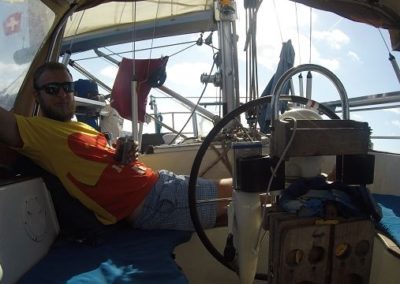
Kevin is steering the boat
-
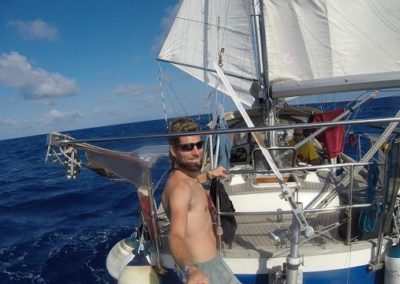
Overlooking the boat
-
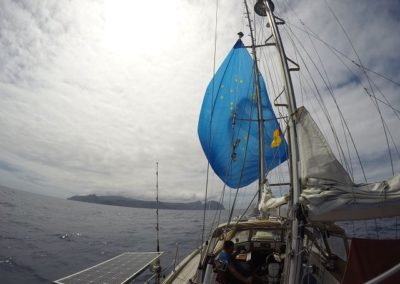
Stak Fok in front of St. Helena
-
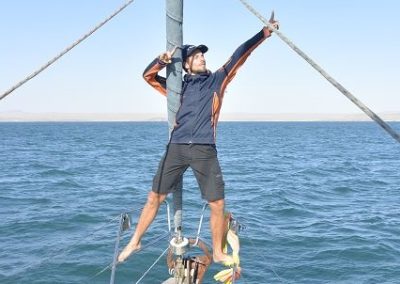
I am the King
-
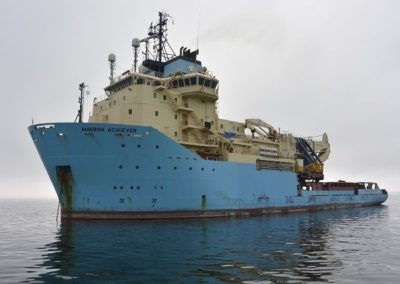
Working ship
-
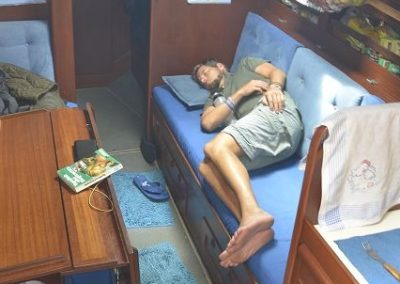
Stephan is tired
-

Yammy, Rösti
-
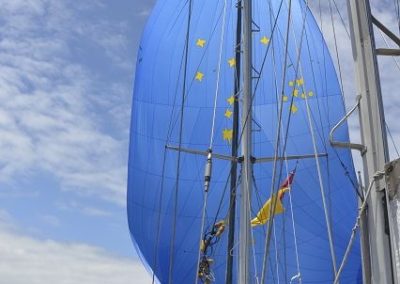
Stak Fok
-
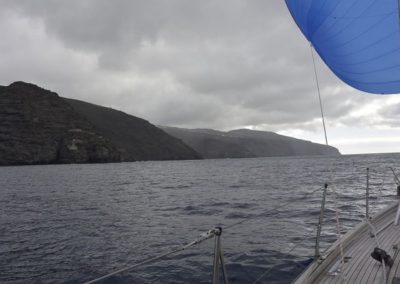
St. Helena
St. Helena
Etwa hundert Seemeilen vor der Insel St. Helena haben wir wieder Funkkontakt. Meistens aber hören wir nur die süsse Frauenstimme, nicht der des Schiffes.
Mit der Spinaker lässig vor dem Bug schwebend, segeln wir um die Insel rum in den Hafen von Jamestown. Die Insel ist gar nicht so klein, wie angenommen. Von weitem haben wir schon gesehen, dass die Inselbewohner oder Touristen per Flugzeug anreisen können. Bis 2018 verkehrte ein sogenanntes Postschiff zwischen Kapstadt und St. Helena.
Im Jahre 2016 wurde der Flughafen fertig gebaut und löste den Schiffsverkehr ab. Es hat Vor- und Nachteile in der Versorgung. Zudem ist die Landebahn eine der gefährlichsten auf der Welt. Einerseits wegen der begrenzten Start- und Landebahn, andererseits wegen der starken Seitenwinde. Die Post ist jetzt schneller unterwegs, doch Gerüchte sagen es dauert immer noch zwischen drei und acht Monaten. Meine Eltern bekamen meine handgeschriebene Postkarte nach fünf Wochen.
So ganz nebenbei erwähnt, wir durchfahren die Ziellinie um 17.10 Uhr und sind somit auf Rang 9 der Regatta Kapstadt – St. Helena. Weil wir zu später Stunde ankommen, dürfen wir nicht an Land gehen. Den Rest des Abends bin ich mürrisch. Ich freute mich so fest, nach dieser langen Passage, wieder Land unter den Füssen zu spüren und da es heut Samstag ist, in den Ausgang zu stürzen. So hechte ich halt ins kalte Meer, als Dusche gedacht. Am nächsten Tag gehts per kleiner Fähre an Land. Das Dingi können wir nicht zu Wasser lassen.
Tagebuch: 05. Januar 2019
Per kleiner Fähre gehts an Land. Das Dingi können wir nicht zu Wasser lassen, weil die Brandung zu gefährlich ist. Alle Yachten hängen an einer Mooring. Ein Mann vergisst etwas auf seinem Cat, steigt aus und klettert wieder auf die Fähre um. Irgendwie kommt mir diese Körperhaltung und Hinterkopf bekannt vor. Und dann sehe ich sein Gesicht. Ich dachte, dies kann nicht wahr sein, unmöglich. Ich setze meine Sonnenbrille ab und sage ihm, kennen wir uns nicht? Und er sagt überrascht: “Hei, der Schweizer Velofahrer!” Den anderen Passagieren erzähle ich, dass ich mit dem Radl von Norwegen nach Kapstadt gefahren bin. In Malawi campierte ich auf einem schönen Camping, der sich in Cape Mclear am malerischen Malawisee befindet. Der Camping ist nur ein kleiner Teil. Nebendran ist eine gut ausgestatte Lodge. So lernte ich Obri kennen, der von beiden stolzer Besitzer ist. Siehe Malawi Bericht. Die Welt ist schon verdammt klein und dass mitten im grossen Atlantik.
Drei Crews von drei Yachten deklarieren zusammen ein, obwohl es Sonntag ist kommen die Leute und begrüssen uns alle freundlich. Danach müssen wir uns bei der Polizeistelle melden. Während dem Spaziergang durch Jamestown, der Hauptort der Insel bemerken wir, dass jeder und jede einander begrüsst, uns eingeschlossen. Jeder kennt jeden hier. Die Einwohnerzahl beträgt 4500. Autos hat es leider 5000. Doch eine Rushour gibt es hier nicht.
In einem schmucken englischen kolonial Hotel genehmigen wir uns Kaffee und Kuchen. Das WiFi kostet hier 3.30 Pfund die halbe Stunde, etwa das teuerste auf dieser Kugel. Gestärkt unternehmen wir eine kleine Wanderung auf den dahinter liegenden Hügel. Es hat viele Festungen mit richtig gut gebauten mehrstöckigen Räumen. Die Kanonen sind riesig. Für den Munition Nachschub bauten sie einen Lift vom Keller nach oben. Die Deutschen mit ihren mickrigen Bunkern in Dänemark können gleich einpacken.
Die Jacobs Ladder hat 699 Stufen, der Rekord liegt bei 5.5 Minuten. Wir wagen es und probieren den Rekord zu brechen. Kevin hat 8.5 Minuten. Oben hat man eine Ausgezeichnete Aussicht auf Jamestown und den Hafen. Es hätte einer der coolsten Tennisplätze für Roger Federer, hoch oben mit Blick auf den Atlantik und mitten im Atlantik. Auch hier hat es neuere Geschütze. Zurück im Hotel wo wir Kuchen gegessen haben, berieten wir den morgigen Tag. Ich sage nur: “Wir könnten… blabla…” Jens fiel mir ins Wort: “Ich habs langsam satt mit deinen Sonderwünschen!” Hallo?? Ist der beklopt? Er kann einfach nicht kommunizieren und das soll ein Anwalt sein und erst noch im Familienrecht, lachhaft. Wenn alle nichts sagen, muss ja einer den Stall misten. Im Organisieren ist er eh, glaube ich, ne Niete. Wir gehen alle einzel zurück aufs Boot.
Tagebuch: 06. Januar 2019
Früh am Morgen wieder per Fähre aufs Land. Ist noch alles ruhig im Hafen, doch im Städtchen ist ab halb 8 “Rush-our”. Viele Arbeiter parkieren ihr Auto auf dem grossen Parkplatz vor der Kirche. Aber noch mehr kommen mit grossen Taxi Bussen, steigen aus, sagen uns Guten Tag mit einem Lächeln und gehen direkt zur Arbeit. Wir sassen auf einer Bank und schauen dem Geschehen zu. Die Inselbewohner sind immer offen für einen Schwatz, wie auch der Mann, der neben uns auf der Bank sitzt.
Die Insel hat ihre eigene Währung, eigene Radiostation und zwei Zeitungen. Seit 2016 ein eigener Flughafen, das Postschiff wurde leider letztes Jahr eingestellt. Ein Flug nach Südafrika kostet 1000$. Es hat viele verschiedene Vögel, wie der St. Helena Regenpfeifer, der sogar auf dem Staatswappen zu sehen ist. Es gibt über 455 Arten von wirbellose Tieren auf der Insel, wie etwa die St. Helena Bernsteinschnecke. Ausserdem verfügt die Insel über einen beinahe perfekten Bienenbestand.
St. Helena ist ein britisches Überseegebiet im Südatlantik. Die Insel ist einer der entlegensten Orte der Welt, und eines der außergewöhnlichsten Reiseziele. Dem einmaligen Charakter und der unberührten Schönheit liegen die vielfaltigen und atemberaubenden Landschaften, das reichhaltige Kulturerbe und eine Umwelt mit einer unglaublichen Artenvielfalt zugrunde. Die Portugiesen entdeckten St. Helena im Jahre 1502. Während der Zeit des Britischen Imperiums wurde die Insel zu einem strategisch wichtigen Hafen.
Der Punkt im Atlantik diente Napoleon als Exil. 1821 starb er. Wir unternehmen einen Safari Trip mit anderen Yachties. Per Bus fahren wir alle wichtigsten Sehenswürdigkeiten ab, wie das Grab von Napoleon, sein Domizil, der Flughafen und das grosse Haus der Gouverneurin mit seinen 2 Schildkröten. Eine heisst Speedy.
Kevin und ich gehen Gemüse einkaufen, weil die Bauern nur zweimal pro Woche die Dörfer mit Gemüse beliefern, Montag und Mittwoch und dann hats so lange wie es hat. Bei den Eiern ist es auch so ne Sache. Nur wenige Läden haben Eier und werden auch nicht jeden Tag beliefert. Wir haben Pech, wir finden kein einziges Ei. Obwohl dieses Produkt wichtige Vitaminen beinhaltet, wir hoffen wir fischen genug Fische. Hier auf der Insel läuft es anders beim Einkaufen als auf dem Festland. Man nimmt die Lebensmittel nicht nur aus dem Regal, sondern auch aus den Körben der Kunden. So kann es gut vorkommen, wenn man zu seinem Einkaufskorb zurück kommt und seine Ware befindet sich nicht mehr drin. Alle Leute hier sind sehr hilfsbereit, man fragt, und man bekommt eine freundliche Antwort oder uns wird geholfen all die unzähligen Äpfel einzupacken. Da ich nicht weiss, wieviel die Einkäufe kosten, können wir unsere Waren im Supermarkt deponieren, zur Bank gehen, um den genauen Betrag abzuheben und später bezahlen. Zurück auf dem Boot fragen wir per Funk ein paar Yachten, die wir kennen gelernt haben, ob sie Reste ihrer Lebensmittel haben. Mein Freund aus Malawi (Südafrikaner) mit ihrem riesen Katamaran beschenkt uns fürstlich. Viel Gemüse, zuviele Kartoffeln und ein wenig Fleisch. Auch viele Eier waren im Fresspacket.
-
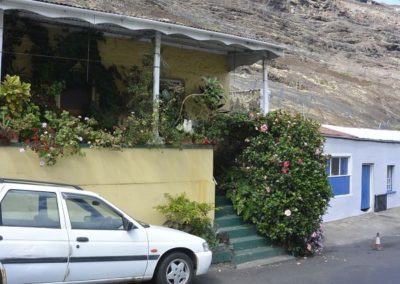
Jamestown, St. Helena
-
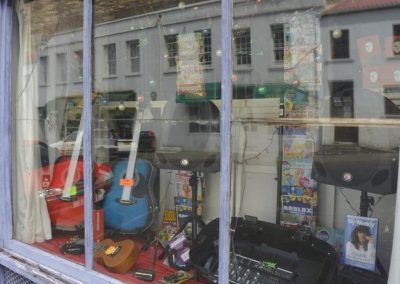
Jamestown, St. Helena
-
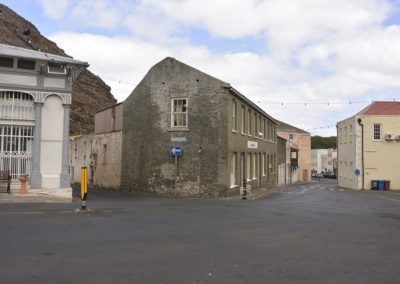
Jamestown, St. Helena
-
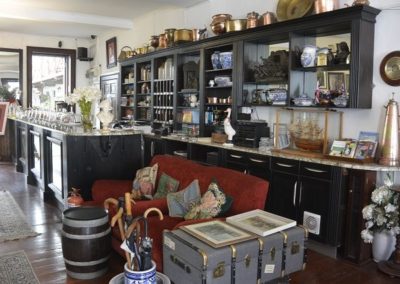
Jamestown, St. Helena
-
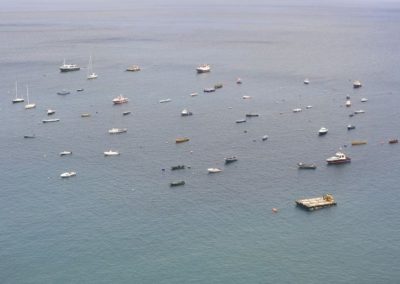
Jamestown, St. Helena
-
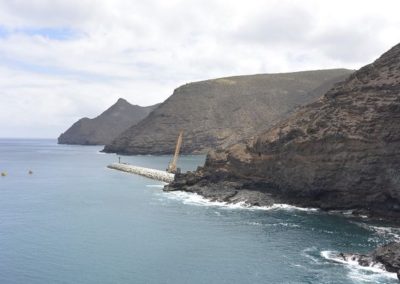
St. Helena
-
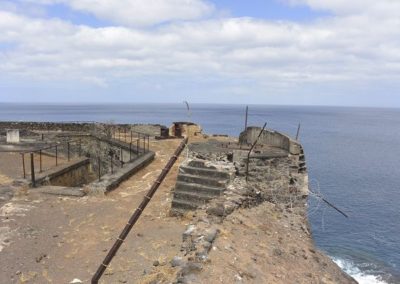
St. Helena
-
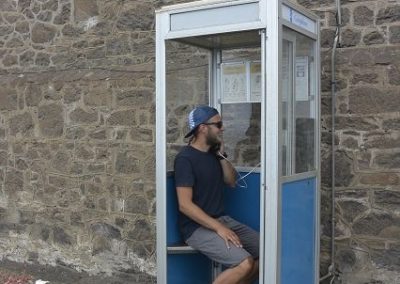
There are still Telepones
-
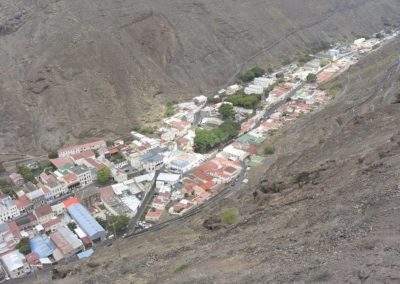
Jamestown, St. Helena
-
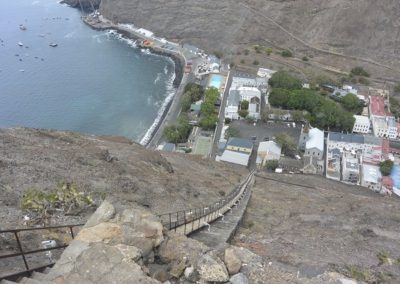
Jamestown, St. Helena
-
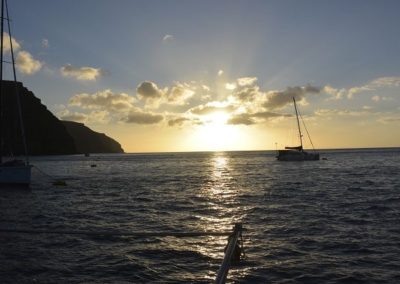
Sunset over St. Helena
-
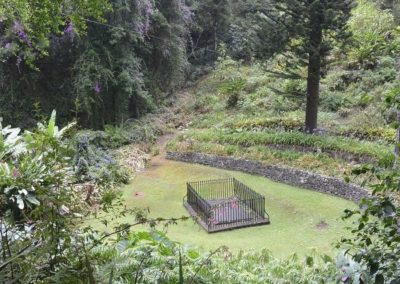
Grave of Napoleon
-
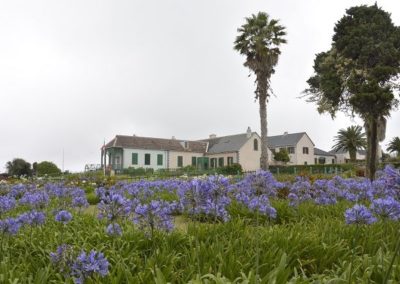
Napoleon's house
-

Airport on St. Helena
-
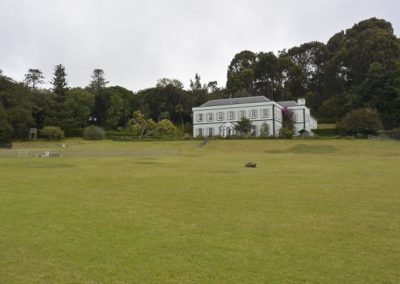
Governour's house and its tortois
St. Helena nach Fernando de Noronha
Von Walvis Bay nach St. Helena sind es 1200 Seemeilen. Wir hatten elf Tage.
Von St. Helena nach Brasilien sind es 1750 Sm. Also mindestens achtzehn Tage, falls der Wind gut bläst. Pro Tag rechnen wir von einem Etmal von 100 Seemeilen/Nautische Meilen. Ein Etmal ist die in 24 Stunden auf einen Zielpunkt gut gemachte Distanz.
Am 8. Januar 2019, um 15.30 Uhr setzen wir zum zweiten Teil der Atlantik Überquerung an. Diesmal setze ich mit Kevin die Schmetterlingssegel, die Fok und die Genua. Kevin ist ein guter Lehrer, sehr geduldig. Ich lerne erfolgreich. Bei dieser Arbeit weiss man was eine Genua ist, desweitern Fok, Baum, Grossmast, Klampe belegen, Palmstik, Genua Schot und Fok Schot. Der Kurs beträgt weiterhin 295°.
Im Salon explodierte der Orangensaft, während ich am Kissen horche. Wenn man eine Tetra Pack einmal öffnet und sie bei einer Hitze von mehr als 30° Celsius liegen lässt, passiert so etwas. Auf Deck spülen wir den Sitzüberzug aus.
Ob wir streiten auf dem Boot, wollt ihr wissen? Ne, eigentlich nie und wenn, dann in ruhigem Ton oder ich halte einfach meine Schnauze und denke meine Dinge. Ich habe zu sehr Angst, beim nächsten Hafen raus geworfen zu werden. Den Deutschen gegenüber hat man eh immer Unrecht. Eines konnte ich nie verstehen, dass ich nie das Kochen konnte, was ich wollte. Jens sagte immer, wir müssen Gas sparen. Hei, im nächsten Hafen einfahren und Gasflasche auffüllen und ausserdem haben wir noch eine Zweite. Er meint belehrerisch, er habe die Flaschen in Thailand gekauft und sei nicht sicher, ob der Anschluss bei der Auffüllstation passt (so einer kann noch nie gereist sein).
Ich zeichne das Segelschiff von allen Seiten auf ein Blatt Papier und kennzeichne alle Dinge, die man wissen muss, wie zum Beispiel Schot, Grosbaum, oder Salin. Die Knoten übe ich auch mit Kevin zusammen. Mastwurf, Doppelter Mastwurf, Abschleppknoten und den Palmstik. Anja Rosenberg schaffte es nicht mir den beizubringen. Kevin zeigt ihn mir einmal vor und ich kann es. :-)
Am 11. Januar 2019, um 01.30 Uhr sind wir in der Mitte des Atlantiks. Die ‚Mitte des Atlantiks‘ feiern wir um die Mittagsezeit des folgenden Tages. Wir nehmen die Segel runter, sodass das Boot an Geschwindigkeit verliert, ziehen uns nackt aus und springen ins Wasser. Herrlich, mitten auf dem Atlantik, unter uns 5000 Meter nichts als Wasser. Wir machen ein Wettrennen, wer zuerst um das Boot geschwommen ist. Das erfrischende Bad lässt uns nicht länger im Wasser verweilen, abtrocknen, anziehen, und die Segel setzen. Abendessen: Älpler Maccaroni mit Bohnen.
Tagebuch: 13. Januar 2019
Seit St. Helena haben wir keine Yacht, auch kein Containerschiff gesehen. Seit Tagen sind wir von der Farbe blau umgeben. Vorallem wenn die Sonne scheint, ist das Meer leuchtend dunkelblau und der Himmel ist auch blau. Der Funkverkehr kommt zum Erliegen, was dazu führt, dass wir ihn ausgeschaltet haben, um Strom zu sparen. Gestern Abend haben wir einen einzigen grösseren Vogel gesehen, so weit vom Land entfernt, merkwürdig. Er umkreist weit oben unser Boot und segelt Richtung St. Helena weiter. Hat wohl gedacht, auf dieser schaukelnden Nussschale werde ich ja seekrank. Auch sonst hat es keine andere Lebewesen. Die letzten Delfine haben wir kurz nach der britischen Insel gesehen. Wale hat es seit Kapstadt nicht mehr gegeben. Frustrierend hängen die Köder der Angelruten vom Sonnenaufgang bis Sonnenuntergang im Wasser, ohne gebissen zu werden. Hie und da segelt ein Schwarm fliegende Fische von unserem Boot weg. Sie fliegen in Wirklichkeit nicht, sondern segeln mit ihren langen Flossen. Der Grund des Segelns liegt darin, dass sie von einem Raubtier flüchten, indem sie kurze Zeit über der Wasseroberfläche segeln, um ihrem Feind den Wind aus den Ohren zu nehmen.
Die Sternen in der Nacht funkeln nicht so hell, wie üblich. Im Dunkeln kann ich nicht sehen ob es Schleierwolken hat. Das Southern Cross finde ich nicht am Nachthimmel, dafür der liegende Bär und andere bekannte Sternbilder von denen ich den Namen nicht weiss. Nicht einmal ein Flugzeug ist aus zu machen, auch keine Satelliten oder Sternschnuppen.
Lang schlafen. Gerade als ich aus der Dachluke unserer Koje schaue, sehe ich, dass die schöne Schweizer Flagge gegen mich zeigt, Halbwind. Gehe rauf zur Brücke. Jens sitzt im Salon und liest, Kevin schläft in der Plicht. Und das Boot steht im Wind. Ist eigentlich allen egal, wann wir ankommen? Mir nicht. Jens müsste als erfahrener Segler merken, aber er entpuppt sich mehr und mehr als eine Flasche. Er setzt einfach ein Segel und meint, man könne ohne etwas zu machen/verändern den Atlantik überqueren. Kevin meint später ironisch, man könne gerade so gut ein 4-jähhriges Kind auf ein Segelschiff setzen, Autopilot einschalten und in Brasilen auf ihn/sie warten. Oder erster Hund überquert den Atlantik solo. Als Fressnapf müsste man einfach eine Maschine hinstellen, wo der Hund ein Hebel betätigen kann. Schön dressiert macht er es nur 2x am Tag.
Jens liest den ganzen Tag. Im Bordbuch schreibt er von Langeweile. Er könnte uns ja unterhalten, Witze erzählen, mir das Segeln beibringen oder ein Spiel spielen. In 24h sagt er vielleicht 10 zusammenhängenden Sätze und wenn er mal etwas erzählt, dann wie ein typischer aussehender Deutscher. Sieht so aus, als ob er schmatzt, verzieht sein Gesicht, sodass sich der seitliche Hals strafft. Das können nur Deutsche. Ich habs versucht, ich schaffs einfach nicht, ausser wenn ich sehr doof drein schaue…
Kevin fing ein Spiel an. Der erste, der was sagt, hat verloren.
………………………………….Kevin wünscht uns Guten Appetit, somit hat er verloren!!!
Nichts spezielles zum Abendessen. Resten von gestern, Mais und Eier. Wir haben soviele Eier, dass wir die einfach gebrauchen müssen. Jens isst wie ein Vögelchen. Wetten, dass er in seiner Schicht wieder voll zuschlägt? Kevin und ich putzen immer viel runter. Kevin zeigt mir ein Foto auf seinem Handy vom Schiffverkehr auf dem Atlantik. Hunderte! Aber wir haben seit der Insel kein einziges gesehen. Irgenwie fürchten wir uns.
Wir bilden uns ein, ob wir vielleiht eine Warnung des Seerettungsdienstes verpasst haben? – Ganzer Atlantik gesperrt, wegen einem Atom Bombentest. Wir würden ziemlich blöd gucken, wenn auf einmal neben uns einen Pilz aus dem Meer auftauchen würde. Schon haben wir etliche Rettungsmassnahmen einstudiert. Ich schlage vor, rasch ein Foto zu schiessen, und dann rasch ins Meer zu hüpfen, dort mindestens dreissig Sekunden zu verharren. In der Hoffnung, dass die Sengungswelle schon vorüber gezogen ist beim Auftauchen. Da das Segelschiff verstrahlt sein möge, sich hinterher ziehen lassen bis nach Brasilien. Ist ja schon alles eingestellt.
An schönen Tagen gewöhne ich mir an, ein frisches Bad zu genehmigen, auch wenn das Boot volle Fahrt von nicht mehr als 4.5 Knoten hat. Als Sicherheit hänge ich ein Seil raus, falls mir aus Versehen die Leiter aus den Händen gleitet. Ich werde immer mutiger. Am Ende des Seiles mache ich einen Knoten rein, somit spüre ich das Ende des Seiles, wenn ich mich nach hinten gleiten lasse. Ich drehe mich um meine eigene Achse und spiele so im Wasser. Ob es hier Haie hat? Ich weiss es nicht.
Es gibt einfach einen von Dreien, der frisst oder trinkt die leckersten Sachen im Nu weg. Ich nenne jetzt keine Produkte, denn dann wäre schon alles klar, wer der Untäter ist (natürlich nur, wenn der Betroffene den Bericht liest). Das ist gegenüber den anderen zwei gewaltig unfair. Erstens teilen wir die Kosten, also ist der zweite Punkt Glasklar….wir teilen auch die Esswaren.
Am 19. Januar 2019, 00.53 Uhr werfe ich eine Flaschenpost in den Atlantik in der Hoffnung, dass sie jemand findet. (Anmerkung des Autors: ein Brasilianer fand am 27. April 2019 meine Flaschenpost am Strand Baia Formosa, Rio Grande do Norte, Brazil) Nach etwa sieben Tage sichten wir das erste Schiff auf dem AIS, auch physisch, nur neun Seemeilen hinter uns kreuzt es. Kevin funkt es wieder an. Es scheint so, als ob die Crew immer aus Phillipinos besteht. Und nie eine Frau an Bord ist, denn wir fragen immer danach. Auch sie uns.
Hie und da werden wir von Delfinen besucht. Jedes Mal ein besonderes Erlebnis. Wir beobachten sie solange, bis sie wegschwimmen.
Man kann auch auf dem Atlantik Wäsche waschen und zwar, indem man ein Seil durch alle Kleider zieht und sie dann ins Meer wirft. Das andere Ende des Seiles sichert man am Heck, wartet etwa eine halbe Stunde und die Kleider sind durchgewaschen. An der Sonne trocknen, der Wind bläst die Salzkristalle aus dem Stoff.
Wie schon erwähnt, sehen wir seit Tagen keine andere Menschen, keine Schiffe, keine Tiere, auch keine Vögel. Wir segeln etwa 250 Seemeilen südlich von der Insel Ascension durch und werden von ein paar Vögel besucht. Wir denken, dass es ein paar Vögel gibt, die auch den Trans-Atlantik machen, denn hie und da, setzt sich ein Vogel in der Nacht auf die Reeling hinten beim Heck und macht Pause. Von Pause kann wohl kaum die Rede sein. Das Schiff schwankt extrem hin und her, der Vogel muss sich ständig festkrallen auf der rutschigen Stange. Früh am Morgen putzt er sich ausgiebig und fliegt weiter.
-

The boat
-
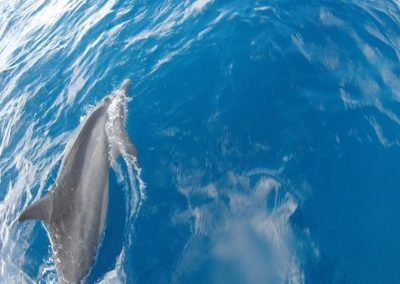
Dolphins
-
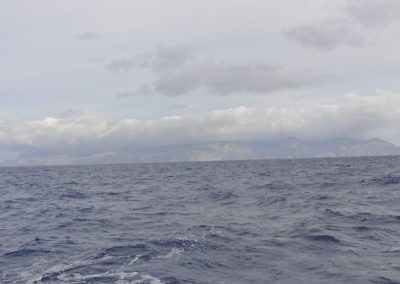
Leaving St. Helena
-
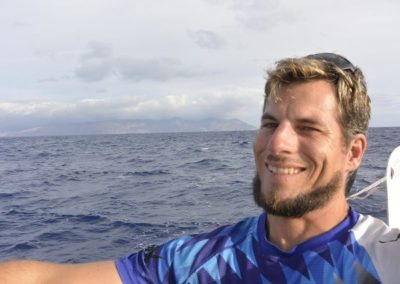
Leaving St. Helena
-
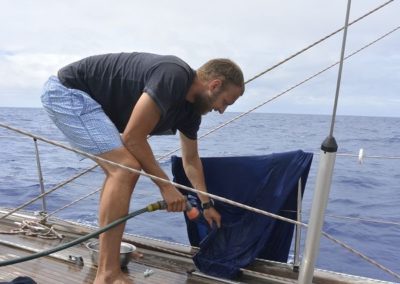
Washing day
-
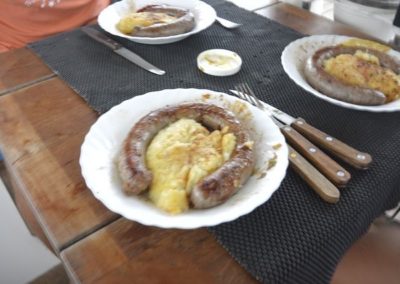
Rösti with causage
-
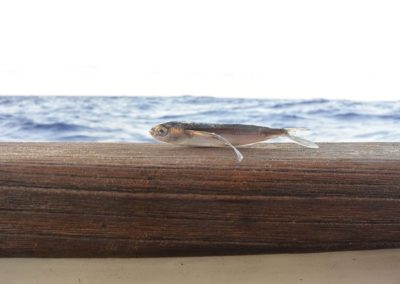
Flying fish
-
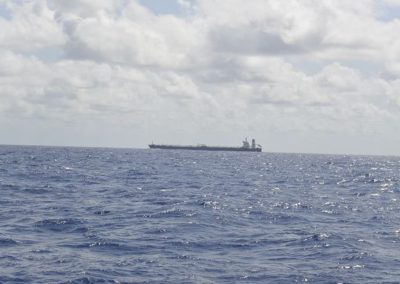
Oil tanker
-
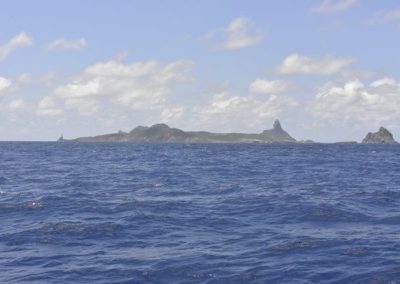
Fernando de Noronha
-
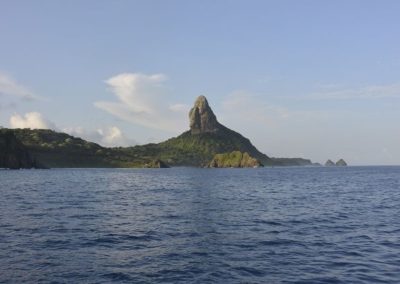
Fernando de Noronha
-
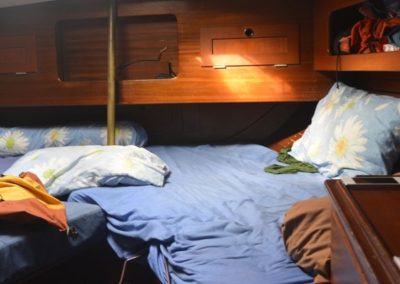
My bed
-
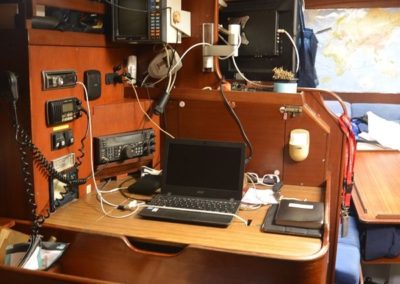
Office
-
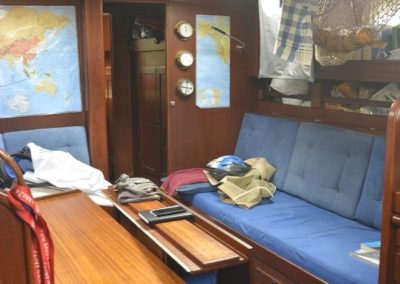
Saloon
-
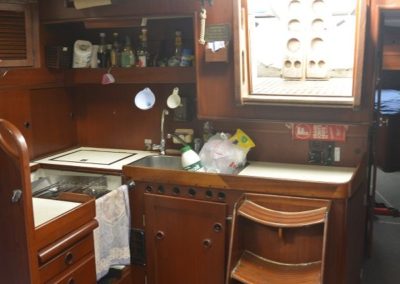
Kitchen
-
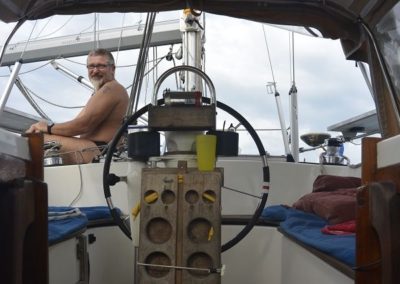
Jens the skipper
-
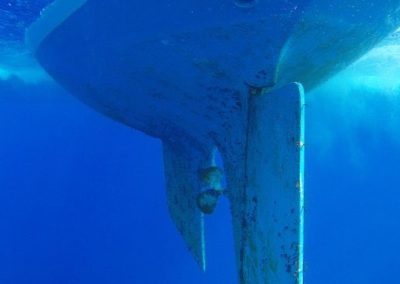
Underwaterworld
-
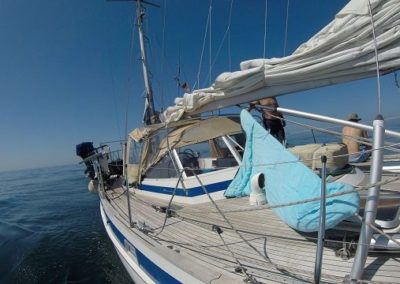
Drying the sheets
-
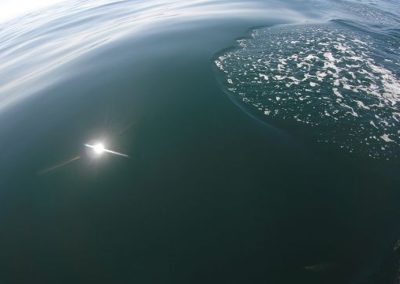
The sun is too much sometimes
Insel Fernando de Noronha
Am 25. Januar 2019, nach 19 Tagen segeln sichten wir die brasilianische Insel. Erleichtert ist das falsche Wort, wie ich mich in diesen Stunden fühle. Ich will endlich wieder festen Boden unter den Füssen spüren, etwas anderes machen als segeln, einen Drink zu mir nehmen, tauchen, tanzen oder einfach lang spazieren. Das Ankern in der schönen Bucht vor der Insel ist leider idiotisch teuer, auch alles wofür man Geld ausgeben kann. So kommen nur die reichen Brasilianer in den Urlaub hierher. Für mein Abendessen im Restaurant bezahle ich 30$ und ist nicht mal köstlich.
Mit dem Wind kommen wir gut auf die nördliche Insel, da sie flach ist. Kevin und ich nehmen die Segel runter. Unter Motor fahren wir ins Hafenbecken ein. Es befinden sich drei andere Segelschiffe da, Engländer, Franzosen und ein Schweizer, was eine Seltenheit ist. Nach dem Anker werfen, gratulieren wir uns gegenseitig für die erfolgreiche Trans-Atlantic Überquerung.
Gestartet am 25. Dezember 2018 in Walvis Bay, Namibia
Ende der Überquerung am 25. Januar 2019 bei einer Insel 100 Sm vor Brasilien namens Fernando de Noronha
Dauer: 32 Tage, mit Zwischenstop in St. Helena (2 Tage)
Das Einklarieren beansprucht wieder viel Zeit. In der Coconut-Bar rede ich seit Tagen wieder mal mit einer Frau, tat richtig gut. Lilian erzählt mir von dem harten Leben auf der Insel während ich ein Caipirinha schlürfe. Auch für sie ist es masslos teuer, sie hat ein Buschhäuschen südlich von Rio, arbeitet hier in der Bar für vier Monaten. Sie erklärt mir, wo das Haus steht, in dem sie in dieser kurzer Zeit wohnt. Auf meinem langen Spaziergang quer über die Insel komme ich daran vorbei. Es steht alleine auf einer grossen Fläche, ringsrum saftiges Gras und einen imposanten 270° Blick auf die Küste.
Auf meinem Spaziergang komme ich an den schönsten Stränden von ganz Brasilien vorbei. Trinke Kokosmilch, esse Mangos und Bananen. Da die Insel zu 2/3 National Park beträgt, hat es keine Kühe, auch keine Ziegen. Bis 1987 war es ein militärischer Stützpunkt.
In der Bucht sehen wir jeden Morgen hunderte von Delfinen, auch drei grosse Schildkröten nehmen ein Bad.
-
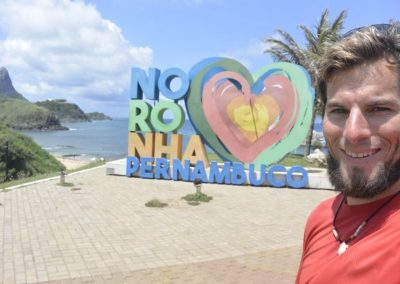
Island Fernando de Noronha, Brazil
-
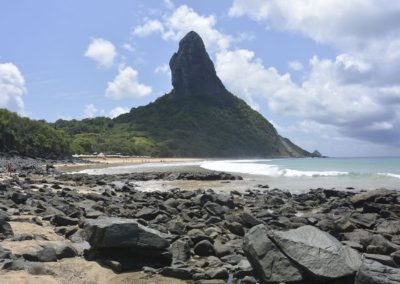
Island Fernando de Noronha, Brazil
-
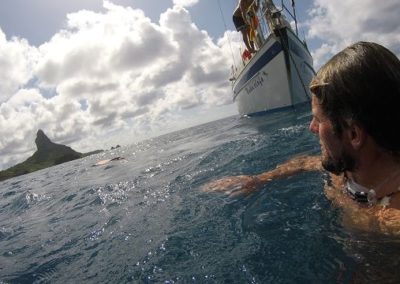
Island Fernando de Noronha, Brazil
-
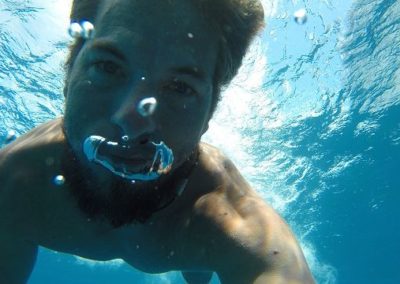
Island Fernando de Noronha, Brazil
-
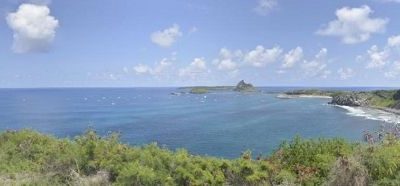
Island Fernando de Noronha, Brazil
-

Island Fernando de Noronha, Brazil
-
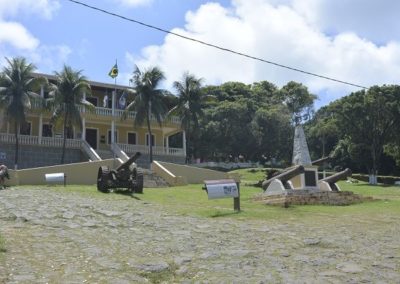
-
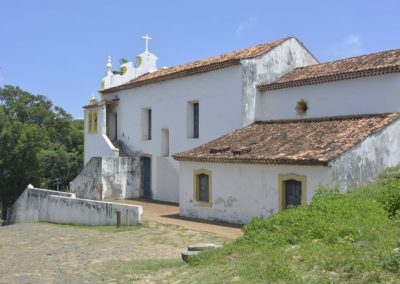
Island Fernando de Noronha, Brazil
-
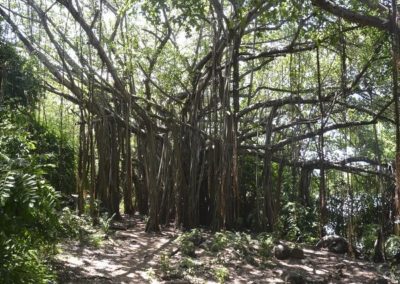
Island Fernando de Noronha, Brazil
-
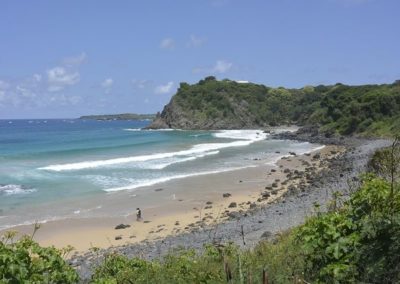
Island Fernando de Noronha, Brazil
-
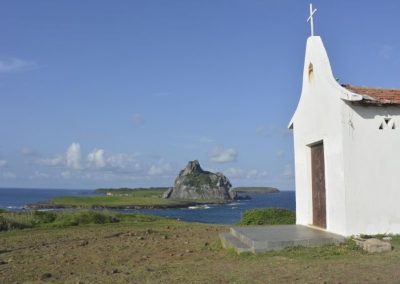
Island Fernando de Noronha, Brazil
-

Island Fernando de Noronha, Brazil
Fernando de Noronha nach Grenada
Das Passatsegeln ist vorbei. Wie schon erwähnt ist der Wind in der Nähe vom Äquator sehr schwach, das Gebiet nennt sich die Doldrums. Wir tümpeln etwa vier Tage lang mit 0 – 3 Knoten nordwestlich. Bei wenig Wind kann man das Spinaker setzen was aber nur eine Windstärke von zehn Knoten erträgt. Hinter uns zieht ein Gewitter auf. Der Wind wird stärker, doch Jens nimmt es bei 15 Kn immer noch nicht runter. Als er gerade überlegte es runterzunehmen erfasst uns eine Böe von 18 Kn, wir sehen es auf der Windmesser Anzeige. In diesem Moment stehe ich hinten am Heck mit Blick zur schönen blauen Spinaker mit vier gelben Sternen drauf, absolvierend meine Kraftübungen. Ratsch! Weit oben, nahe beim Einziehring reisst es durch die ganze Breite, flog mit dem Wind nach vorne ins Wasser.
Wegen dem Salz stockt unsere Susi, das Windruder. Ohne Windruder ist man noch nicht ganz aufgeschmissen, weil es noch den Hugo (Autopiloten) gibt. Der Nachteil ist, dass er viel Batterie braucht und bei starkem Wellengang zu schwach ist. Hugo! Wegen dir müssen wir von nun an von Hand steuern. So bleibt uns nichts anderes übrig auch am Tag Schichten einzulegen. Da es anstrengender ist, kürzen wir die Zeiten auf zwei Stunden pro Mal, so haben wir immer vier Stunden Pause. Die Pausen nutzen wir um zu kochen, essen, schlafen, baden/duschen oder sonnen.
Vermehrt geraten wir in heftige Gewitter. Ein Gewitter erzeugt Sturmwind. Bei einem Gewitter reisst die Genua ein. Fehlentscheid die Genua früher einzuziehen. Von da an ziehen wir sie immer ein, wenn schwarze Wolken auf uns zurasen. In der Nacht ziehen wir vorsichtshalber die Genua halb oder ganz ein.
Ich könnte Bücher schreiben, was in den nächsten Tagen wegen den krassen Gewittern abgeht, doch leider wird dann der Bericht zu lang. Ich kann nur sagen, ich merke langsam, dass das Segeln nicht immer ein Zuckerschleck ist, sondern sehr gefährlich sein werden kann. Warum gibt es das Fachwort Nock-down? Oder warum gibt es ein Rettungsboot (rund um Kap Hoorn in Südamerika ist ein leeres Rettungsboot gefunden worden, das deutsche Pärchen verschwunden; für immer)? Das Mann-über-Bord geht nur bei Tageslicht gut aus. Bei Nacht ist man zu 99.9% verloren. (Anmerkung der Redaktion: es gibt Schwimmwesten mit Sendern…)
Anyway, wir können froh sein, dass die Genua noch Segel tauglich ist. Jens entfährt wieder mal einer seinen beeindruckenden Sätzen: „Warum hast du die Genua nicht reingeholt?“ Mein Gott, ich habe nicht die Erfahrung, es ist nicht mein Boot und daher treffe ich bestimmt keine Entscheidungen. In meinem Auge ist der Skipper schuld, weil er zu spät reagiert hat und Kevin, der gross gewachsene Hühne, mit seinem Bierbauch hat keine Kraft, um an einem Seil ein bischen zu ziehen.
Abendessen? Keiner hat Hunger. Jens schon gar nicht. Ich koche mir Pasta mit am Vorabend gekochter Käsesuppe als Sauce. Mmmhh, lecker!
Die Wellen werden von den heftigen Winden von den Gewittern grösser und höher. Ich benenne sie unter anderem Lift-Welle, wenn das ganze Boot von einem Wellental nach oben auf einen Wellenberg geschoben wird. Oben haben wir einen weiten Rundumblick auf den Ozean, unten im Wellental sehen wir nur blaues Wasser. Eine andere Bezeichnung ist die Dong-Welle. In der Kombüse hat es eine mittelgrosse Glocke mit einem schön gestrickten Strick, mit dem man lautstarke Klänge erklingen kann. Ich, als Koch, benutze sie immer zehn Minuten bevor das Abendessen fertig ist, damit die anderen wissen und Zeit haben, den Tisch in der Plicht aufzustellen und sich an den Tisch setzen können.
Wenn also eine Monsterwelle das Segelschiff auf 45° Schräglage drückt, ertönt ein Dong. Die Ding-Dong Welle erfahren wir zum Glück nur etwa zweimal.
Blauwasseregeln heisst:
Weit weg segeln von der Küste, weg vom Land und den Zwängen der Zivilisation! Segeln auf den Weltmeeren, dort, wo wegen der vielen tausend Meter Tiefe unter dem Kiel das Blau des Meeres sich irgendwo im Unendlichen verliert… Dies genau hab ich mit den eigenen Augen Netzhaut Nah gesehen, als ich mich immer wieder mal am Seil, welches ich am Heck befestigt habe, im Kielwasser zehn Meter hinter dem Boot herziehen ließ. So habe ich auch, wahrscheinlich einer von höchst einem Dutzend Menschen auf der ganzen Welt (in Küstennähe ausgeschlossen) den Äquator ‘schwimmend’ überquert. Der, dies auch gemacht hat, bitte melden.
Vor dem Abendessen lassen wir seit ein paar Tagen den Motor im Leerlauf etwa 45min rotieren, um die Batterien aufzuladen und gleichzeitig eine Salzwasser Dusche zu genehmigen, so sind wir frisch für das Abendmahl. Irgendwelche Elektrogeräte fressen zuviele Wattstunden. Zum Beispiel das AIS (autom. Identifizierung System) haben wir den Sender ausgeschaltet, jedoch nicht den Empfänger, so sehen wir immer noch die Schiffe um uns herum kurven. Froh sind wir auf jeden Fall auf den grossen Kühlschrank. Abendessen Reis mit Dosengemüse-Omelett.
-
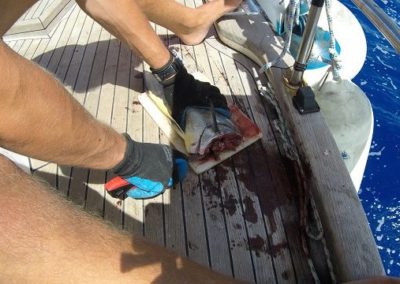
Caught another nice fish
-

Dont leave me!
-
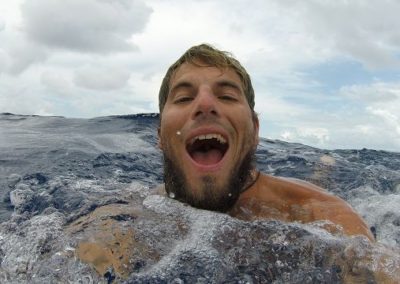
I am still here
-
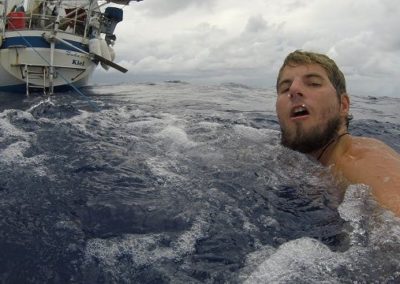
Swimming over the Equator
-
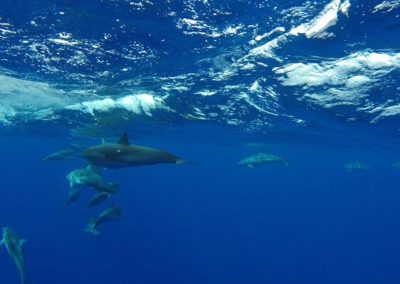
With the dolpins
-
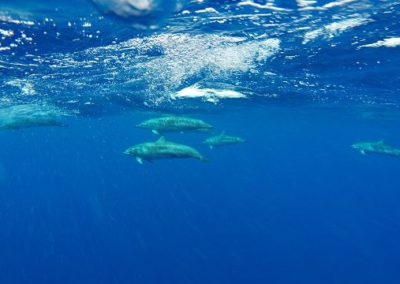
Awesome!
-
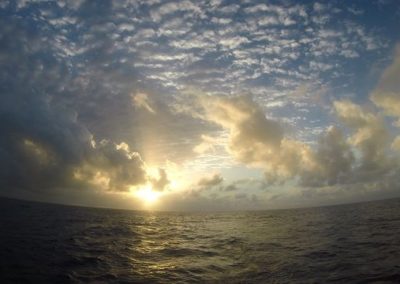
Sunrise
-
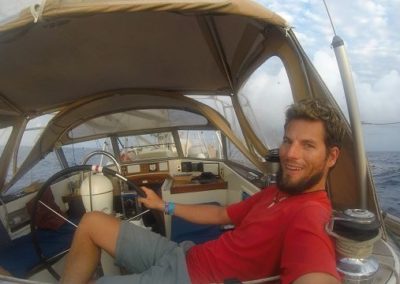
Easy job, steering the boat
-
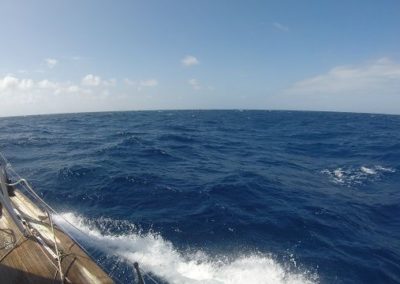
It looks qualm but it is not
-
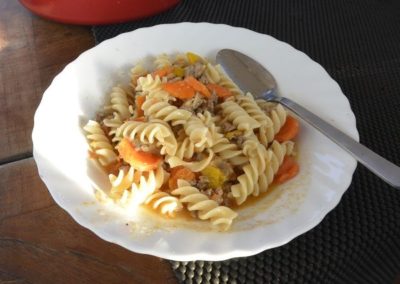
Pasta with carottes
-
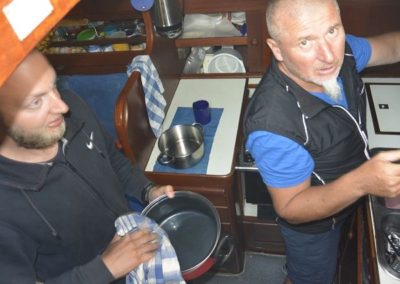
I cook, the others doing the dishes
-
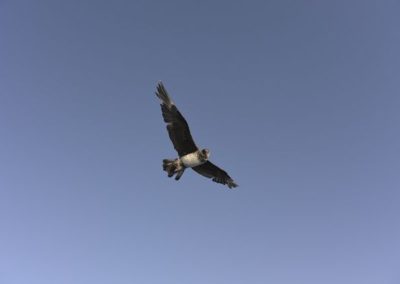
Sometimes we have visitors
-
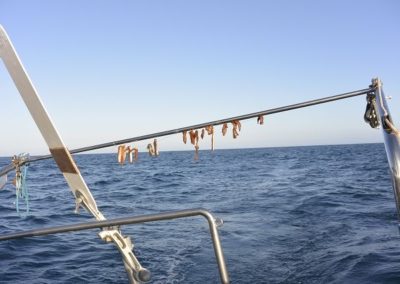
Drying the fish
-
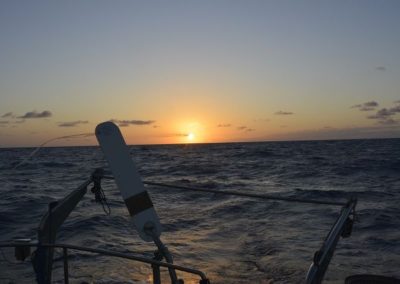
Windruder Susi
-
Is it underwater or the sky?
Grenada
Von der Insel de Diable machen wir nur ein doofes Touristikfoto und weiter gehts. Wieder eine Fehlentscheidung! Meilenweit im Luv der Insel die Segel runter zu nehmen und davon ausgehen, dass man gegen starke Strömung und mässigen Wellengang mit einem schwachen Dieselmotor vorwärts kommt, weiss sogar ein Landgänger. Trotzdem überbieten wir an diesem Tag unseren eigenen Rekord von 152 Seemeilen. Nun sind es etwa fünf bis sechs Tage bis Grenada. Ich bin müde, ausgelaugt, durchgeschüttelt, ausserdem Kopfweh. Ich kann es kaum erwarten für mehrere Tage festen Boden unter den Füssen zu spüren, mich körperlich betätigen. Meine Gymübungen kann ich seit der Insel Fernando de Noronha nicht mehr ausführen, weil es zu stark windet, das Boot daher schräg liegt und wir viel schneller unterwegs sind, schneller am Ziel und vorallem macht es so richtig Spass zum Segeln. Endlich mal action!
Am späteren Nachmittag trudeln wir in St. George’s auf Grenada ein. In der Wartungsschlaufe sehen wir schon mal ein kleiner Teil der Insel. Die Yachtmarina ist recht gross und hat einen stolzen Preis von 70€/Nacht. Die teuerste Motoryacht im Hafen, unter englischer Flagge, gehört einem israelischen Geschäftsmann. Es ist die 62. grösste Yacht der Welt und kostet um die neunzig Millionen Dollar.
Auf eigene Faust schaue ich mir das Städtchen an. Leider hat es viel zu viele Autos, keine Gehsteige. Die Einwohner sind fast alle schwarz, Nachfahren von Sklaven, die von Westafrika auf bestialische Weise von den Engländern, Holländern und Franzosen über den Atlantik transportiert wurden. Ein Millionen Geschäft. Etwa eine Million Afrikaner kamen so in die Karibik, eine weitere Million starben auf dem Weg oder wenig später nach der Ankunft. Christoph Kolombus entdeckte die Karibik und meinte es seien Vorinsel vor China. Kurzerhand liess er dann mal alle Einwohner ausrotten, aus welchen Gründen auch immer.
Kevin geht hier von Bord, weil seine Freundin ihn so sehr vermisst (…).
-
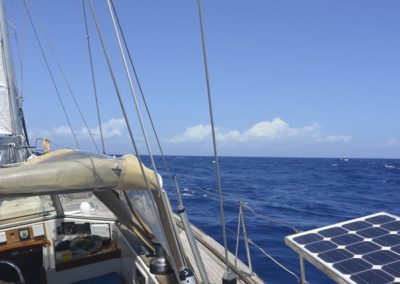
On the way to Grenada
-
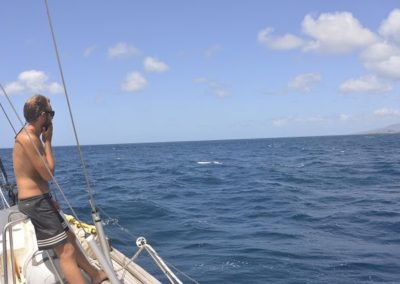
Kevin explored Grenada
-
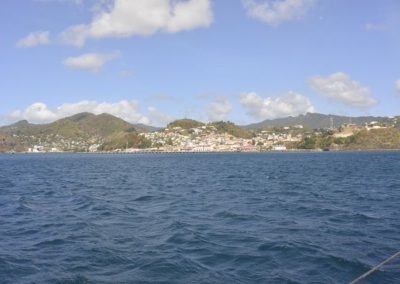
Grenada
-
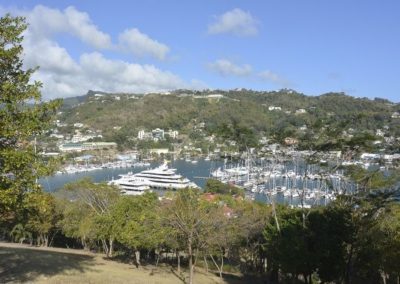
Grenada
-
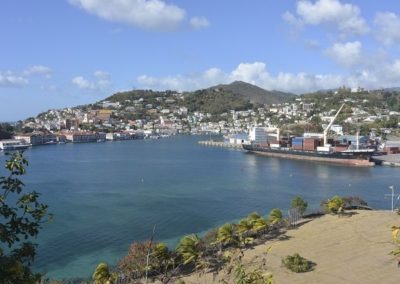
Grenada
-
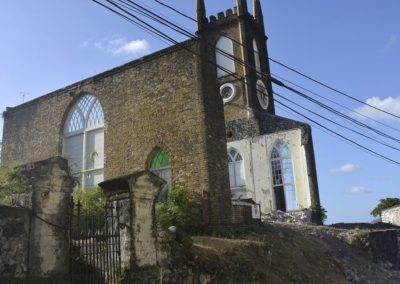
Grenada. Church demolished by a hurrican
-

Grenada
-
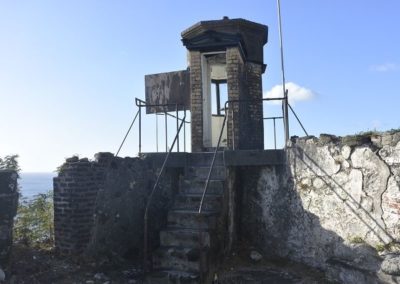
Grenada
-

Grenada
Haiti
Was sagen die Reisemagazinen, Werbungen und Zeitungsartikeln? Schönes Segeln in der Karibik mit mässigem Wind und blauer See. Irgendwas stimmt da nicht. Wir haben zwischen 15-35 Knoten Wind, so hohe Wellen, dass wir uns zwölf Tage nicht duschen können. Einmal versucht es Jens zwar, verliert dabei fast das Boot, weil ein Tritt abgebrochen ist. Ohne das Sicherheitsseil hätte ich rufen können: „Danke für das Boot!“ Denn eine Sicherheitseinweisung bekam ich nie, was aber in unserem Mitsegler-Vertrag ausführlich beschrieben ist. Nicht einmal wo der Feuerlöscher sich befindet wird mir gezeigt.
Der Wind weht nun also so stark, dass wir nicht einmal die verschiedenen Inseln ansteuern können. Komischerweise überholen uns mehr als ein Dutzend Segelschiffe, ob die auch alle direkt nach Haiti/Kuba abgetrieben worden sind?
Das Mooringseil, um das Boot im Hafen zu befestigen, habe ich vergessen einzusammeln. Als wir wieder mal gegen die Wellen ankämpfen wollen und den Motor starten wollen, geriet das Seil in die Schraube und murkst den Motor ab. Jens verletzt sich am Rücken, macht den Salontisch kaputt, ich glaube, auch er braucht eine Pause.
Die Insel A Vache kommt erst spät in Sicht, weil es eine flache und kleine Insel ist. Nahe der Insel passe ich vorne beim Bug auf. Bei jeder Plastikflasche gebe ich Signal mit der Handhupe und zeige mit dem Arm nach links oder rechts wo sie ist, ein Zeichen von Fischernetzen. Ein richtiges Slalom Manöver. In einer schönen Bucht gehen wir vor Anker, geschützt vom kräftigen Wind. Kaum angekommen, kommen viele Einheimische mit ihren Einbaums angepaddelt und wollen dies und jenes verkaufen. Und jeder Schurke verlangt frech hohe Preise. Bananen für 20$, Gasflasche auffüllen 45$, vier Kokosnüsse 4$ etc.
Ich nehm gleich ein Salzwasser Duschbad, nach zwölf Tagen auf See ohne Salzwasserpumpe und rauher See. Danach entferne ich das restliche Seil, das noch fest um den Propeller gewickelt ist.
Auf unserem Spaziergang über die Insel sehen wir zwei Helikopter nahe einem Resort stehen, die reiche Touristen einfliegen. Eine richtige paradiesische Insel mit schönen Stränden, Palmen, ruhiges Inselleben. Nur dass die Leute ständig Wucherpreise anbieten ist ein Jammer. Rauf auf einen Hügel gehts zurück zum Dorf. Schöne Aussicht auf die Beach mit dem Resort und einem runden See mitten auf der kleinen Insel. Das Dorf hat nicht viel zu bieten. Barbier 5$. Keinen richtigen Shop. Nicht viel Gemüse und überhaupt keine Früchte. In einem munzigen Restaurant essen wir feine Lobster.
Haiti sollte das ärmste Land der Welt sein? Sieht gar nicht danach aus. Es befinden sich schöne Häuser mit geschmückten Steinwänden auf der gesamten Insel. Die Leute tragen alle Flipflops oder sogar Schuhe. Die Schule ist sehr gross, zweistöckig, farbig angemalt. Sie fahren mit Mopeds herum anstatt mit Eselskarren. In Afrika leben sie krass anders, ärmer. Weil die Medien von Demonstrationen berichten, bleiben leider die Touristen aus, obwohl die Insel A Vache absolut sicher ist.
Kuba
Nach dem Ausschlafen, macht Jens und ich Klarschiff. Ab gehts Richtung Kuba…
Ich bin am Steuer, Jens hält nach Fischernetzen Ausschau. Schönes blaues Wasser, auch der Wind weht ordentlich, so setzen wir die Segel. Entlang der Hauptinsel segeln wir zu unserem Fixpunkt, um dann nur noch in eine einzige Richtung, Richtung Leuchtturm zu segeln, welcher auf einer Anhöhe rechts einer schönen Festung steht, gebaut von den Spaniern.
Früh am Morgen bei schönstem Sonnenaufgang kommen wir in Santiago de Cuba nach achtundsiebzig Tagen und 6823 Seemeilen auf hoher See an. Was für eine Erleichterung mein geplantes Ziel erreicht zu haben. Ich bin glücklich angekommen zu sein und froh, nie wieder das schaukelnde Boot betreten zu müssen. Das Abenteuer Segeln ist aber noch nicht abgeschlossen, ein weiterer, noch grösserer Ozean steht mir im Weg, aber dann, nur mit einem Katamaran und mit einem Skipper, der nicht sozial inkompetent ist und segeln kann!
-
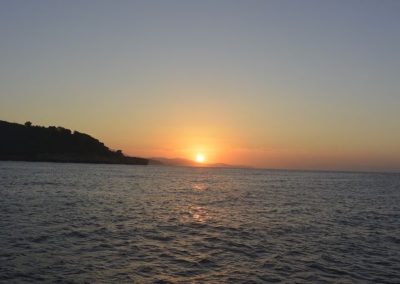
Cuba. Sunrise before we arrive
-
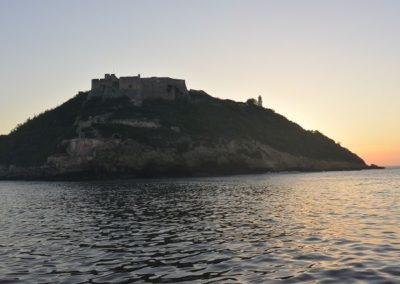
Cuba. Castle
-
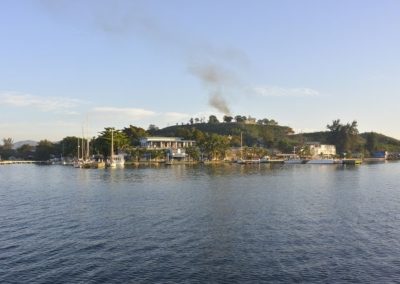
Marina
-
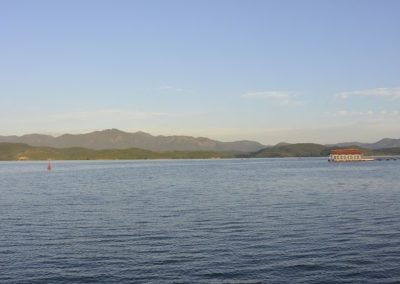
Santiago de Cuba
-
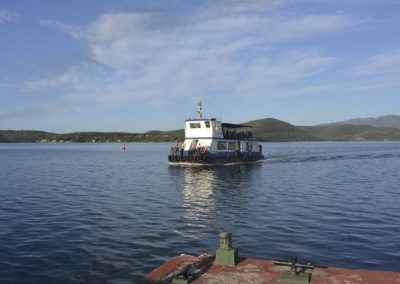
Ferry to the city
-
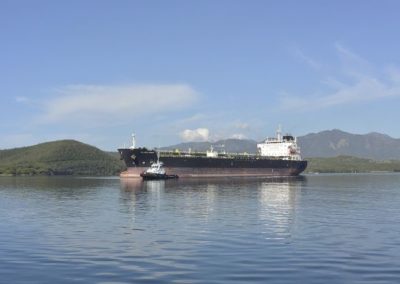
Oil tanker leaving the bay
-
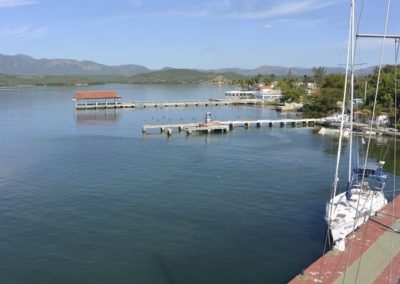
View to Santiago de Cuba
-
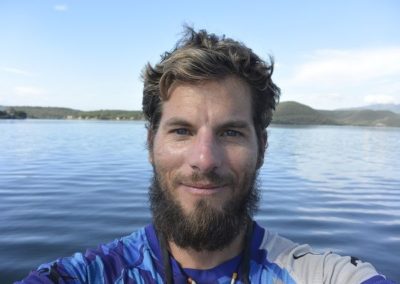
Before....
-
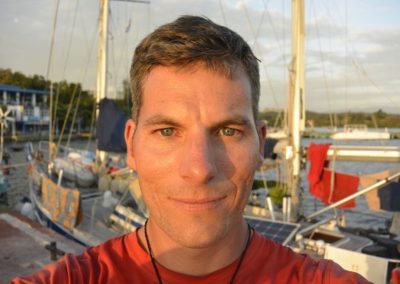
....after
English:
From Cape Town to Lüderitz
Well, after 11 months of anticipation, it’s finally time. My latest crazy adventure is coming up. The last night on land I spent with one of the best hosts, David, whom I say goodbye. With all my posturing I drive to the marina, which is well guarded. Thanks to the skipper’s friends, I reach the landing stage, where Jens, the skipper and the sailor Kevin meet me. In the restaurant, we happily drink one for the time together on the sailing ship Nuku Alofa.
I can not even settle on the ship, it’s already the next morning after a fine breakfast, prepared by Kevin, go to the open sea. Jens lets a tanker, towed by tugboats, the right of way and we chug out of the big marina. Behind us we will see for a long time Table Mountain, the landmark of Cape Town. The tourist Robben Island, where formerly Nelson Mandela was held captive, floats past us. We are really driving faster when we set sail for the first time. More specifically, it is the first time for me, but for Jens the X. Mal, because he started his sailing circumnavigation on 1 August 2018 (actually the 2nd time, because after three days they came in a violent storm, so they had to reverse because of major damage to the ship) in Thailand. After a nap (the farewell party in Cape Town was long and exhausting), the others tell me of jumping whales. Excited, I look for more. Suddenly, about six humpback whales emerge near the port side and blew their fountains into the air. They are swimming right at us. If that only works! In a newspaper article in Mosselbay, I saw a totally damaged sailing ship after a whale plopped onto the ship. Five meters in front of us two dive off and then humming. One actually rammed our boat. Whether the whale did not see us or he could not estimate our draft of 2.10 meters? A short time later, a joyfully jumping whale approaches. But luckily he changes his direction. He is as big as a bus.
As we sail for 24 hours, we divide the night into three shifts of four hours. I’ll take the first one. Jens stays with me for the first two hours and explains me what to do. If the wind turns, I have to turn the steering wheel in that direction. On the AIS (Automatic Identified System), I have to look for ships and bumps and try not to fall asleep. In the last hour I suddenly get too much on the starboard side and thus stand in the wind. I turn and turn the wheel, but the boat does not turn. So I call Jens. He does not sleep yet, so he hears me immediately. The last minutes I control the boat by hand. I fall tiredly into bed.
At night it is a special feeling to steer the boat. My fellow sailors sleep while I concentrate on the course I have programmed for four hours. I am alone, I control the thirteen-meter-long sailing ship alone, it is under my control, I could also head directly to Brazil, which Jens would not like. The moon fills up slowly, the stars shine less. Outside the cockpit I dare not to go, it is cold, windy (luckily) and pitch dark. Without a lifejacket it is not advisable to walk around on the deck, even if you have to. I’m glad when Kevin took over, so I rush to the bathroom and go to bed to warm myself up. The next morning we have breakfast together, a rarity in sailing. They are looking for two ships the AIS tells us. With my eagle eyes, like the sailor on the Maersk Alabama, I immediately see one. Kevin the other. Both huge container ships.
I handle the fish rod, because Jens thinks he’ll get a new bait. The old man is gay, because he has the color pink and is frayed by the strong current or nibbling fish. Back in the bunk, I approve a nap. When I look a little later from the window, I see a big fish filleted in a bowl. And then another Bigeye Tuna. Well, are they all hungry like us again? After two days at sea, our body got used to the swings. I think all three were sleepy, no one wanted to cook something. I never took tablets against seasickness on the whole cruise. In the evening I cook potatoes, carrots and fish. Delicious!
In another change of workshift Jens welcomes me to Namibia. So I hang up the Namibian flag, right of the mast and saluted.
Near Oranjemund, where the great Orange River flows from South Africa into the sea, there is zero wind. So we take off all sails, because the clattering Kevin annoys. I undress and jump into the water. Brrr, that’s cold. Swim around the boat, the others follow me. On the AIS we see many boats, but we see nothing. So I climb, armed with binoculars and GoPro camera on the mast, backed up by Jens. Gorgeous, the view is adorable. Only sky and water, more blue than anything else. Below me the sailing ship looks tiny. I do not see the fishing boats from up here either.
Jens, the skipper, who also owns Nuku Alofa lives in Frankfurt on the Oder, which is a border river to Poland. He is a lawyer, has his own law firm with many employees. In addition, he owns a marina and tried in the construction business, a so-called home-facility.
Kevin is from Nuremberg, now lives in Cologne and has a pretty policewoman as a girlfriend who is painfully homesick. Kevin has some photos hanging over his bunk and it gets one more every Sunday because his sweetheart has given him more than thirty letters. What a love! He works as a chartered accountant, checks various banks.
Shortly before Lüderitz we see more and more seals sunning on their backs, probably taking a break, tired of catching a fish. Also we see some penguins splashing around. The absolute highlight of the day are the dolphins. They love to swim in front of and beside the bow of the ship.
Luderitz
Lüderitz is a small town in the middle of the Naukluft Desert, which is an absolute restricted area for all people. Although the diamond time is more or less over.
Here and there they are still digging. But the heyday is definitely over. A good example is the ghost town Kolmanskuppe. We will visit them the next day. Very informative and exciting to listen to, as they used to live better than we do today in Europe. Back on the boat we prepare for the next stage. The water cans, water tanks (700l) and diesel tank from the boat must be filled. In the supermarket, we provide ourselves through the shelves. Not even risotto they have, I’m annoying, because that’s my specialty.
From Lüderitz to Walvis Bay
In strong winds, wind peaks up to forty-two knots ,we drop off. We set the sails only when we are a long way off the coast. After eleven o’clock in the morning, the desert is heated up so much that a strong wind builds up, sweeping through Lüderitz and out to the open sea.
Again I have to put my feet around the head tube, which runs through our bunk. Kevin, with whom I share our bedchamber, kindly approves of this sleeping position, because then my feet rest a bit on his mattress. I told him I was afraid to fall out of bed when the boat tipped over again due to a wave.
On my night watch, Kevin storms to the bridge (command center of the ship) and shouts worried, „Where are you?“
„Here I am,“ I answered.
„I was scared because I did not see you in bed.“ A funny guy. He replaced me this time on time. In Lüderitz he invited me for a drink because he was once too late for the shift. I could not sleep again. This weighing constantly moves my head, in the ear there is a noise (such a scrape from the pillow) that does not make you sleepable. A moving body can not rest. I hear Kevin go to the bathroom. Suddenly, the door pops open with a loud bang and Kevin, who seems to have lost his balance, shoots out. He staggers and moans. „Everything OK?“ „Yes, yes.“ He tries again.
In the morning we are greeted by fifty sea lions at breakfast.
The first packet of pasta I throw overboard with beetles in it. But the minced meat with pepper and pasta (no beetle) tastes all. When sailing, you do not move really sporty, so I do not quite understand why sailing is a sport. I took care of that by organizing a yoga mat in Cape Town. I do my strength exercises almost every day with the help of a workout app. Depending on the waves, I do this in the salon or on deck in the sun. Funny, why is the fishing rod bent so hard? A fish! And what a specimen, again a Bigeye Tuna (a kind of tuna). In a bestial way, they kill him. Kevin prepares it for dinner and a part for drying.
After a nap again one more fish. Man, they can not find food here. It is about three kilograms heavy I hold the very slippery body with gloves, Jens brings with great momentum with the screwdriver to manslaughter. „Stop!“ I shout. „Do you really want to eat it? We already have one, big enough for dinner, and it’s about twice as big. Let it live.“ Said and done. I throw the happy back to the sea, relieved. Unfortunately, I overlook the one iron bar. So he falls on this, then on the bathing platform, before he dives into the wet. He will carry a few injuries.
In the bay in front of Walvis Bay, there is really something going on concerning the shipping traffic. Walvis Bay is the only supply port of Namibia, also for Botsuana, which is a landlocked country. We have to maneuver around some ships before dropping anchor again as in Lüderitz. Since it has no dock, we set our dinghy on the water, hop in and play a game who is allowed to jump first under the long-awaited shower, if it only has one. Next, by WiFi, write to our loved ones at home that we are back a bit further. At this place we do everything we did in Lüderitz vice versa. So get the exit stamp at the immigration office, clear out the boat at the port authority and call all Namibians goodbye and wave with napkins. My motivation right now is in the basement, I was able to pick up my sack that I deposited here, though but I could not make a single skydive in Swakopmund because of Christmas and fog. Christmas is celebrated with another crew (Oroborro) in a restaurant. There are two couples on their way to Rio de Janeiro in Brazil. Kevin promptly fell in love with the Japanese. The others are from Portugal, and USA.
Walvis Bay to St. Helena
On December 25, 2018 at 15.30 we start our long adventure across the Atlantic. After passing the derrick, we put the Gross and the Genoa on the starboard side. The wind blows at 15 to 20 knots, which makes a speed of 5 knots, then 6 knots. After one hour it blows stronger from the southeast, which brings us to 7.5 knots. I always say, more is better. Jens disagrees. I do not have to pay for any repairs. At 6 pm, I cook the best Christmas menu, which you can cook on a tilting boat. I can only do everything with one hand, with the other I have to hold myself. The risotto is excellent!
Kevin still can not believe it right, and I think he’s afraid to sail across the Atlantic, just out to sea, hundreds of nautical miles from the coast. We see no more land after only twenty nautical miles. I somehow do not realize that we have just fallen into one of the biggest sailing adventures. Soon I will learn to sail …
At the beginning of a shift everything goes well, but then complete doldrums. The boat turns around its own axis, we drift north because of the waves, and even drive back to the coast. I do not know what to do anymore. I curse the night shift because I’m alone and I do not know if I’m doing the right thing. I dont wanna wake anybody Will not wake anyone. Fortunately, Jens comes to the bridge, could not sleep, because of the noise of beating ropes. He corrected it. Things are going well for a while, then chaos again. Suddenly the wind is refreshing to 14 knots. I tighten the genoa, go back to the right course. Huiii, that’s fun. I am sailing alone on the Atlantic Ocean.
On the website www.handgegenkoye.de I found Jens. For his circumnavigation he was looking for sailors, who also take over shifts, so that he can lie down every night. Since we are allowed to sail almost free, we tackle where we can actively. Since I like cooking and I know that the others can not cook (Kevin cooks too spicey and Jens can not or is too lazy), I do this job. The cook is the captain!
In the on-board cash everything comes to mind, such as food / drinks, harbor fees or water / gas / diesel. However, if something breaks down, the owner has to pay, unless it is grossly negligent.
Jens was asked by various sailors. One wrote: „I am an experienced sailor, do not have much money, but have a lot of time, whether I may sail for free?“ Jens’s answer was: „I am no charity.“
The other also asked for a free crossing, he would be a freelance photographer and would take great pictures, which he will sell for a fee to Jens. If they were not all Germans, I would have been really worried about humanity.
For some time now we see a cargo ship at a speed of only 2 knots. Over the radio he warns us to stay away from him. Very suspicious. Who will re-spark it and ask him what’s going on? Of course not the two hare feet. I spark:
„Andriotis, Andiotis, Andriotis for Sailing Vessel Nuku Alofa over.“
„Go ahead,“ he replies.
What kind of vessel is it and what do you transport?
„It is a tanker and a transport oil“
„Why dont you have speed?“
„We drift with 2 Kn. We do maintenance on the engine.“
Maintenance on the high seas?
„I am a mechanic, can you need any help?“
It was more of a joke than serious, but why not? I once applied as a service technician at a company in Winterthur, who build, install, repair or service marine engines, even on the high seas. Since then you will be dropped off as a technician by helicopter on the deck.
„No, thank you. Please, stay clear on canal 16.“
„No worries, thank you very much for those informations, over and out.“
What a naughty boy. In German, that means like, be quiet, we have better things to do.
There are shifts, there you can read books, it is so quiet. But there are shifts that are persistent. For example, when the wind is constantly turning on its own axis and blowing once weak, once strong. In a night shift I have between 5 and 30 knots. Again and again I have to change the course, which results in a tedious zig-zag course. Then calm again all day to push the boat forward to 8.5 knots at night with gusts up to 40 knots. Once I even have 10.2 knots cruise speed, record speed between Cape Town and Cuba.
Slept restlessly, as the sea is so stormy and time and again brings the boat in extreme imbalance. Leave Jens in the morning, he goes to sleep, can not sleep before he started his shift. Sleepy, I look to the anemometer. There is no ship nearby on the AIS that we can collide with. Woo, a huge wave is swarming all over the stern. Our gap to the cabin is open. I’ll take a look. Ups, Kevin’s clothes, sleeping bag and mattress are dripping wet. Later we discover three stowaways on the deck. The fish had to be flushed with the big wave on board. One is a flying fish. They can not fly, but sail close to the surface of the water a few hundred meters, fleeing from a predator.
Again the old shit song, sometimes strong, sometimes weak wind. I have to constantly correct. I could never have seen a movie on my laptop, reading is also an art. Darn dirty wind. Once I stand in the wind for a few minutes, until I realized that I have turned the steering wheel wrong. This is the end of a crappy shift, tired, concentration zero (3 o’clock in the morning). The other time the ship has hit the page, the nut box falls to the ground, opens up, the mice got their feast. I curse so loud that both guys are standing in front of me in their underpants.
On December 30, 2018 we were called the Stak Fok. This is similar to the Genoa, also at the front of the bow, but is hung in a steel cable. Can not be rolled up like the genoa. Thus, we sail butterfly-like west, that’s called Passat sailing -> sailing with the trade winds. The season of the trade winds between South Africa and Brazil is roughly between November and February. During this time, the wind blows from the southeast to the northeast and to the equator, where the winds are weaker, until they are replaced by the winds in the North Atlantic. Additionally comes the Gulf Stream pushing the boats to the northwest. Sailing from west to east is not impossible, but you have to put up with a laborious crossing, you lose your time and patience.
Kevin is radioing the Titanica ship that day. The radio operator is himself from India. The cargo ship transports cars from Germany to Australia. Probably a RoRo ship, which I spotted in Bremerhaven at the beginning of my journey.
Little happens on the New Year. Moderate wind, no fish caught, so only warmed up risotto. Since we will be sailing over six time zones between Cape Town and Cuba, we will reset the clocks by one hour today. This is how my shift starts at midnight, exactly in the new year. Everyone is on the bridge and toasting with a tiny sip of champagne. Alcohol on board is prohibited, which I welcome. The emergency rockets had gotten old. The first dives into the water in a flash, about a hundred meters from our boat. The second kindles in the tube. Fortunately, Jens reacts properly and throws it into the water. He almost flared his boat.
At noon I prepare the healthiest salad. Tomatoes, cucumbers, mozzarella, eggs, avocado, carrots and basil. Hey, yummy!
If one compares the distance from Walvis Bay to St. Helena and from St. Helena to Brazil on the world map (Jens has one in the salon so he can draw his itinerary), one might think that it is half; only you, you get a dull feeling in the epigastrium. Already on the shorter route you can slowly get the crisis. How is it, who thinks of the longer distance? Slight panic comes up. At least eighteen days on the high seas, no or few ships around, no women, food is slow, no fresh food. The worst thing is, you have nothing to do. Sleep, eat and read, that’s it. If you are lucky, you catch a fish. The power supply is enough on many days not even to charge the laptop. No watching movies during the night shift. Do not write reports. The fresh water is coming to an end. On board, there is a desalination machine that pumps water, which tastes like stale broth. Just bad.
St. Helena
About a hundred nautical miles off the island of St. Helena we have radio contact again. But most of the time we only hear the sweet female voice, not that of the ship.
With the spinaker casually floating in front of the bow, we sail around the island in the port of Jamestown. The island is not so small as expected. From a distance we have already seen that the islanders or tourists can arrive by plane. Until 2018, a so-called mail boat operated between Cape Town and St. Helena.
In 2016, the airport was completed and replaced the shipping traffic. It has advantages and disadvantages in the supply. In addition, the runway is one of the most dangerous in the world. On the one hand because of the limited runway, on the other hand because of the strong crosswinds. The post office is now faster, but rumors say it still takes between three and eight months. My parents got my handwritten postcard after five weeks.
By the way, we pass the finish line at 17.10 and are ranked 9th in the Cape Town – St. Helena regatta. Because we arrive late, we can not go ashore. The rest of the evening I’m grumpy. I was so happy, after this long passage, to feel land underfoot again and as it is Saturday to fall into the exit. So I pike into the cold sea, thought as a shower. The next day we go by small ferry ashore. We can not let the dinghy go.
Diary: 05 January 2019
On a small ferry goes ashore. We can not let the dinghy water because the surf is too dangerous. All yachts hang on a mooring. A man forgets something on his cat, gets out and climbs back onto the ferry. Somehow this posture and back of the head is familiar to me. And then I see his face. I thought, this can not be true, impossible. I take off my sunglasses and tell him, do not we know each other? And he says surprised: „Hey, the Swiss cyclist!“ I tell the other passengers that I cycled from Norway to Cape Town. In Malawi I camped on a beautiful camp site in Cape Mclear on the scenic Lake Malawi. The camping is only a small part. Next door is a well equipped lodge. That’s how I met Obri, who is the proud owner of both. See Malawi report. The world is already damn small and that in the middle of the big Atlantic.
Three crews from three yachts declare together, although it’s Sunday, people come and greet us all friendly. After that we have to report to the police station. As we walk through Jamestown, the island’s main town, we notice that everyone welcomes each other, including us. Everyone knows everyone here. The population is 4500th Cars it has unfortunately 5000th But there is no Rushour here.
In a neat English colonial hotel we allow ourselves coffee and cake. The WiFi costs 3.30 pounds half an hour, about the most expensive on this globe. Strengthened, we take a little hike on the hill behind. It has many fortresses with really well-built multi-storey rooms. The cannons are huge. For the ammunition supply, they built a lift from the basement up. The Germans with their puny bunkers in Denmark can pack right away.
The Jacobs Ladder has 699 steps, the record is 5.5 minutes. We dare and try to break the record. Kevin has 8.5 minutes. Upstairs you have an excellent view of Jamestown and the harbor. It would have one of the coolest tennis courts for Roger Federer, high up overlooking the Atlantic and in the middle of the Atlantic Ocean. Again, it has newer guns. Back in the hotel where we ate cake, we advised the next day. I say only: „We could … blabla …“ Jens interrupted me: „I’m getting sick of your special wishes!“ Hello ?? Is he crazy? He just can not communicate and that should be a lawyer and still in family law, laughable. If everyone does not say anything, somebody has to kill the stable. In organizing, he is, I think, a rivet anyway. We all go back to the boat one by one.
Diary: 06. January 2019
Early in the morning again by ferry to the countryside. Everything is still quiet in the harbor, but in the town is from 8:30 „Rush-our“. Many workers park their car in the large parking lot in front of the church. But even more come with big taxi buses, get out, say hello to us with a smile and go straight to work. We sit on a bench and watch the action. The islanders are always open for a chat, as is the man sitting next to us on the bench.
The island has its own currency, its own radio station and two newspapers. An own airport since 2016, unfortunately the post ship was discontinued last year. A flight to South Africa costs $ 1000. It has many different birds, such as the St. Helena plover, which can be seen even on the state coat of arms. There are over 455 species of invertebrate animals on the island, such as the St. Helena amber snail. In addition, the island has an almost perfect bee population.
St. Helena is a British overseas territory in the South Atlantic. The island is one of the most remote places in the world, and one of the most extraordinary travel destinations. Its unique character and unspoiled beauty are the basis for its diverse and breathtaking landscapes, rich cultural heritage and an environment rich in biodiversity. The Portuguese discovered St. Helena in 1502. During the time of the British Empire, the island became a strategically important port.
The point in the Atlantic was Napoleon’s exile. In 1821 he died. We are going on a safari trip with other yachties. By bus we leave all major attractions, such as the grave of Napoleon, his domicile, the airport and the big house of the governor with his 2 turtles. One is called Speedy.
Kevin and I go shopping for veggies because the farmers only supply vegetables to the villages twice a week, Monday and Wednesday, and then hats for as long as it has. It’s also a big deal with the eggs. Only a few shops have eggs and are not supplied every day. We are unlucky, we can not find a single egg. Although this product contains essential vitamins, we hope we can fish enough fish. Here on the island it is different when shopping than on the mainland. The food is not just taken off the shelf, but also taken from the customer’s baskets. So it may well happen, if one returns to his basket and his goods are no longer in it. All the people here are very helpful, you ask, and you get a friendly response or we are helped to pack all the countless apples. Since I do not know how much the shopping costs, we can deposit our goods in the supermarket, go to the bank to withdraw the exact amount and pay later. Back on the boat, we ask a couple of yachts we’ve met, whether they have leftovers of their food. My friend from Malawi (South African) with her huge catamaran presents us with a princely gift. Lots of vegetables, too many potatoes and a little meat. Also many eggs were in the Fresspacket.
St. Helena to Fernando de Noronha
From Walvis Bay to St. Helena, it is 1200 nautical miles. We had eleven days.
From St. Helena to Brazil it is 1750 Sm. So at least eighteen days, if the wind blows well. Every day we expect a distance of 100 nautical miles. A Etmal is the distance well made in 24 hours to a destination point.
At 8:30 pm on January 8, 2019, we will start the second part of the Atlantic crossing. This time with Kevin I’m putting the butterfly sails, the Fok and the Genoa. Kevin is a good teacher, very patient. I am learning successfully. In this work you know what a Genoa is, in addition Fok, tree, mainmast, cleat occupy, Palmstik, Genoa Schot and Fok Schot. The course is still 295 °.
The orange juice exploded in the salon as I listened to the pillow. If you open a Tetra Pack once and leave it in a heat of more than 30 ° Celsius, something happens. On the deck, we rinse off the seat cover.
Whether we are arguing on the boat, do you want to know? No, never and never, then in a steady tone or I just hold my nose and think my things. I am too afraid to be thrown out at the next port. The Germans are always wrong. One thing I could never understand was that I could never cook what I wanted. Jens always said we have to save gas. Hey, drive in the next port and refill gas bottle and we also have a second. He mentally means that he bought the bottles in Thailand and was not sure if the connection would fit at the refill station (such a can never have traveled).
I draw the sailing ship from all sides on a piece of paper and mark all things that you need to know, such as Schot, Grosbaum, or Salin. I also practice the knots with Kevin. Mast throw, double mast throw, towing knot and the Palmstik. Anja Rosenberg did not manage to teach me. Kevin shows it to me once and I can do it. :-)
At 11:30 am on January 11, 2019, we are in the middle of the Atlantic Ocean. The ‚middle of the Atlantic‘ is celebrated around noon on the following day. We lower the sails so that the boat loses speed, we strip naked and jump into the water. Wonderful, in the middle of the Atlantic, below us 5000 meters nothing but water. We’ll race who has swum first around the boat. The refreshing bath no longer lets us stay in the water, dry, put on, and set the sails. Dinner: Alpine Maccaroni with beans.
Diary: January 13, 2019
Since St. Helena we have seen no yacht, no container ship. For days we are surrounded by the color blue. Especially when the sun is shining, the sea is bright dark blue and the sky is also blue. The radio traffic comes to a standstill, which means that we have switched it off to save electricity. Last night we saw a single larger bird, so far from the land, strange. He circled our boat high up and continued to sail towards St. Helena. I suppose I’ll be seasick on this swinging nutshell. Otherwise it has no other living beings. The last dolphins we saw shortly after the British island. Whales have not existed since Cape Town. Frustratingly, the baits of the fishing rods hang in the water from sunrise to sunset without being bitten. Here and there a flock of flying fish sails away from our boat. They do not actually fly, but sail with their long fins. The reason for sailing is that they flee from a predator by sailing over the surface of the water for a short time to release the wind from their enemies‘ ears.
The stars in the night do not sparkle as brightly as usual. In the dark, I can not see if it has cloud clouds. The Southern Cross I find not in the night sky, but the lying bear and other famous constellations of which I do not know the name. Not even an airplane is out, even satellites or shooting stars.
Sleep long. Just as I look out of the roof hatch of our berth, I see that the beautiful Swiss flag is pointing against me, half wind. Go up to the bridge. Jens is sitting in the drawing room and reading, Kevin is sleeping in the cockpit. And the boat is in the wind. Does not everyone care when we arrive? Not me. Jens would have to remember as an experienced sailor, but he turns out more and more as a bottle. He just sets sail and says you can do something without changing / crossing the Atlantic. Kevin later ironically says that one could just as well put a 4-year-old child on a sailing ship, turn on autopilot and wait for him or her in Brazil. Or first dog crosses the Atlantic solo. As a feeding bowl you would simply have to put down a machine where the dog can operate a lever. Beautifully trained, he only does it twice a day.
Jens is reading all day. In the log he writes of boredom. He could talk to us, tell jokes, teach me to sail or play a game. In 24h he might say 10 coherent sentences and if he tells something, it’s like a typical looking German. Looks like he’s smacking, grimacing his face so the side neck tightens. Only Germans can do that. I tried it, I just can not do it, except when I look very stupid …
Kevin started a game. The first one who says something has lost.
………………………………… .Kevin wishes us good appetite, so he lost !!!
Nothing special for dinner. Remains of yesterday, corn and eggs. We have so many eggs that we just need them. Jens eats like a little bird. Bet that he strikes full again in his shift? Kevin and I always clean up a lot. Kevin shows me a picture on his cell phone about shipping on the Atlantic. Hundreds! But we have not seen one since the island. Somehow we are afraid.
We imagine if we’ve missed a warning from the maritime rescue service? – The whole Atlantic is closed due to an atomic bomb test. We would look pretty stupid if suddenly a mushroom appeared next to us from the sea. We have already rehearsed several rescue measures. I suggest taking a quick photo and then hopping into the sea, staying there for at least thirty seconds. In the hope that the Sengungswelle has already pulled over when surfacing. Since the sailing ship may be contaminated, let yourself be drawn to Brazil. Everything is already set.
On fine days, I get used to getting a fresh bath, even if the boat does not drive more than 4.5 knots. As a security, I’ll hang a rope out if I accidentally slip the ladder out of my hands. I am getting braver. At the end of the rope, I make a knot in, so I feel the end of the rope as I slide backwards. I turn around my own axis and play in the water. Whether it has sharks here? I dont know.
There’s just one of three who eats or drinks the tastiest stuff in no time. I do not name any products now, because then it would all be clear who the wrongdoer is (of course, only if the person concerned reads the report). That’s grossly unfair to the other two. First, we divide the cost, so the second point is crystal clear …. we also share the food.
On January 19, 2019, at 11:53 pm, I throw a bottle mail in the Atlantic in the hope that someone will find her. (Author’s note: a Brazilian found my bottle post on Baia Formosa Beach, Rio Grande do Norte, Brazil on April 27, 2019) After about seven days, we sighted the first ship on the AIS, also physically, only nine nautical miles behind us , Kevin starts it again. It seems like the crew always consists of Phillipinos. And there is never a woman on board, because we always ask for it. She too us.
Here and there we are visited by dolphins. Every time a special experience. We watch them until they swim away.
You can also do laundry on the Atlantic by pulling a rope through all the clothes and throwing it into the sea. The other end of the rope is secured at the stern, waiting for about half an hour and the clothes are washed through. Drying in the sun, the wind blows the salt crystals out of the fabric.
As already mentioned, we have not seen other humans for days, no ships, no animals, no birds. We sail about 250 nautical miles south of the island of Ascension and are visited by a few birds. We think there are a few birds that also do the trans-Atlantic, because every now and then, a bird sits down at night on the railing behind the stern and takes a break. There can hardly be any talk of a break. The ship swings extremely back and forth, the bird must constantly cling to the slippery pole. He cleans himself extensively early in the morning and flies on.
Island Fernando de Noronha
On January 25, 2019, after 19 days of sailing, we sightsee the Brazilian island. Relieved is the wrong word as I feel in these hours. I finally want to feel solid ground under my feet again, do something different than sailing, having a drink, diving, dancing or simply taking a long walk. The anchoring in the beautiful bay in front of the island is unfortunately idiotic expensive, also everything for which one can spend money. So only the rich Brazilians come here on vacation. For my dinner in the restaurant I pay $ 30 and is not even delicious.
With the wind we get on the northern island, because it is flat. Kevin and I take the sails down. Under the engine we drive into the harbor basin. There are three other sailing ships there, English, French and a Swiss, which is a rarity. After the anchor throw, we congratulate each other for the successful Trans-Atlantic crossing.
Started on December 25, 2018 in Walvis Bay, Namibia
End of the crossing on January 25, 2019 at an island 100 sm off Brazil called Fernando de Noronha
Duration: 32 days, with stopover in St. Helena (2 days)
The declaration takes a lot of time again. In the coconut bar, I’ve been talking to a woman again for days, doing really well. Lilian tells me about the hard life on the island while I’m sipping a Caipirinha. Even for her, it is extremely expensive, she has a bush house south of Rio, working here in the bar for four months. She tells me where the house she’s staying in in such a short time. On my long walk across the island I pass it. It stands alone on a large area, surrounded by lush grass and an impressive 270 ° view of the coast.
On my walk I pass the most beautiful beaches of all Brazil. Drink coconut milk, eat mangos and bananas. Since the island is about 2/3 National Park, it has no cows, no goats. Until 1987, it was a military base.
In the bay we see hundreds of dolphins every morning, even three big turtles take a bath.
Fernando de Noronha to Grenada
Passat sailing is over. As already mentioned, the wind near the equator is very weak, the area is called the doldrums. We plod for about four days at 0 – 3 knots northwest. With little wind you can set the spinaker, but only withstand a wind force of ten knots. A thunderstorm is rising behind us. The wind is getting stronger, but Jens still does not take it down at 15 knots. As he was about to wind down, a gust of 18 knots seizes us, we see it on the wind gauge display. At that moment, I’m standing at the back of the stern with a view to the beautiful blue spinach with four yellow stars on it, completing my strength exercises. Ratchet! Far above, near the Einziehring it rips through the whole width, flew with the wind forward into the water.
Because of the salt our Susi, the Windruder, stops. Without Windruder one is not completely in the fix because there is still the Hugo (autopilot). The disadvantage is that it needs a lot of battery and is too weak in strong waves. Hugo! Because of you we have to control by hand from now on. So we have no choice but to lay shifts during the day. Since it is more exhausting, we cut the times to two hours a day, so we always have four hours break. We use the breaks to cook, eat, sleep, swim / shower or sunbathe.
Increasingly, we get into violent thunderstorms. A thunderstorm produces storm winds. The genoa breaks in during a thunderstorm. Wrong decision to confiscate the Genoa earlier. From then on, we always pull them in when black clouds rush towards us. As a precaution we pull the Genoa in half or all at night. I could write books, which in the next few days because of the stark thunderstorms, but unfortunately the report is too long. I can only say, I realize slowly that sailing is not always a picnic, but can be very dangerous. Why is there a technical nock-down? Or why is there a lifeboat (around Cape Horn in South America, an empty lifeboat has been found, the German couple disappeared, forever)? The man overboard only goes well in daylight. At night you are 99.9% lost. (Editor’s note: there are lifejackets with transmitters …)
Anyway, we can be happy that the Genoa is still capable of sailing. Jens once again escapes one of his impressive sentences: „Why did not you bring the Genoa in?“ My God, I do not have the experience, it’s not my boat and so I’m definitely not making any decisions. In my eyes, the skipper is to blame because he reacted too late and Kevin, the big grown chicken, with his beer belly has no strength to pull on a rope a bit.
Dinner? No one is hungry. Jens certainly not. I cook pasta with cheese soup cooked the evening before as a sauce. Mmm, yummy!
Waves become bigger and higher with violent winds from thunderstorms. Among other things, I call them lift-wave, when the whole boat is pushed from a wave trough up to a wave mountain. Above we have a wide panoramic view of the ocean, down in the wave trough we see only blue water. Another name is the Dong wave. In the galley, it has a medium-sized bell with a beautifully knitted rope, with which one can hear loud sounds. I, as a cook, always use them ten minutes before dinner is done, so that the others know and have time to set the table in the cockpit and sit down at the table.
So when a monster wave pushes the sailing ship to 45 °, a dong sounds. Fortunately, we only hear the Ding-Dong wave about twice.
Blue water sailing means:
To sail far away from the coast, away from the land and the constraints of civilization! Sailing on the oceans, where, because of the many thousand feet of depth under the keel, the blue of the sea is lost somewhere in the infinite … This is exactly what I’ve seen with my own eyes Retina Nah, as I always on the rope, which I fastened at the stern, let drag in the wake ten meters behind the boat. So, too, probably one of more than a dozen people around the world (off the coast) I crossed the Equator ‚floating‘. Who has done this, please report.
For a few days before dinner, we let the engine idle for about 45 minutes to recharge the batteries and at the same time approve a saltwater shower, so we are fresh for the Last Supper. Any electrical appliances eat too many watt-hours. For example, the AIS (auto-identification system), we have the transmitter off, but not the receiver, so we still see the ships curve around us. We are definitely looking forward to the big fridge. Dinner rice with canned vegetable omelette.
Grenada
From the island of Diable we make only a stupid tourist photo and on we go. Again a wrong decision! Miles away in the windward of the island to take the sails down and assume that one comes forward against strong current and moderate swell with a weak diesel engine, knows even a country traveler. Nevertheless, we beat our own record of 152 nautical miles on this day. Now it’s about five to six days to Grenada. I’m tired, drained, shaken, and headache. I can not wait to feel solid ground under my feet for several days, to be physically active. Since the island Fernando de Noronha I can no longer do my gymnastics exercises because it winds too hard, so the boat is at an angle and we are much faster, faster at the finish and especially fun for sailing. Finally action!
In the late afternoon we arrive in St. George’s on Grenada. In the maintenance loop we can already see a small part of the island. The yacht marina is quite large and has a proud price of 70 € / night. The most expensive motor yacht in the harbor, under the English flag, belongs to an Israeli businessman. It is the 62nd largest yacht in the world and costs around ninety million dollars.
On my own I look at the town. Unfortunately, there are far too many cars, no sidewalks. The inhabitants are almost all black, descendants of slaves who were brutally transported from West Africa by the English, Dutch and French across the Atlantic. A million business. About one million Africans came to the Caribbean, another million died on the way or a little later after arrival. Christopher Kolombus discovered the Caribbean and said it was Vorinsel in front of China. Without further ado, he then had all the inhabitants exterminated, for whatever reason.
Kevin leaves here because his girlfriend misses him so much (…).
Haiti
What do the travel magazines, advertisements and newspaper articles say? Beautiful sailing in the Caribbean with moderate wind and blue sea. Something is not right. We have between 15-35 knots wind, waves so high that we can not take a shower for twelve days. Jens once tried, almost loses the boat, because a kick is broken. Without the safety rope, I could have called, „Thanks for the boat!“ For a safety briefing I never got, but what is described in detail in our Mitsegler contract. Not even where the fire extinguisher is located is shown to me.
The wind is so strong that we can not even drive to the different islands. Strangely enough, more than a dozen sailing ships overtake us, whether they have all been driven off directly to Haiti / Cuba?
I forgot to collect the mooring rope to fix the boat in the harbor. As we want to fight against the waves again and start the engine, the rope got into the screw and murkst the engine off. Jens injures his back, breaks the saloon table, I think he also needs a break.
The island of A Vache comes late in sight, because it is a shallow and small island. Near the island, I watch the front of the bow. With every plastic bottle, I signal with the hand horn and point with my arm to the left or right where it is, a sign of fishing nets. A real slalom maneuver. In a beautiful bay we drop anchor, protected by the strong wind. As soon as arrived, many locals with their dinghies befallen and want to sell this and that. And every rogue cheeky demands high prices. Bananas for $ 20, gas bottle $ 45, four coconuts $ 4 etc.
I take a saltwater shower bath, after twelve days at sea without saltwater pump and rough sea. Then I remove the remaining rope, which is still wrapped tightly around the propeller.
On our walk across the island, we see two helicopters standing near a resort that is being used by wealthy tourists. A real paradise island with beautiful beaches, palm trees, quiet island life. Only that the people constantly offer usurious prices is a pity. Up on a hill you go back to the village. Beautiful view of the beach with the resort and a round lake in the middle of the small island. The village does not have much to offer. Barber 5 $. Not a real shop. Not much vegetables and no fruits at all. In a cozy restaurant we eat fine lobster.
Haiti should be the poorest country in the world? Does not look like it. There are beautiful houses with decorated stone walls throughout the island. People all wear flip flops or even shoes. The school is very large, two-storey, painted in color. They use mopeds instead of donkey carts. In Africa they live in a different way, poorer. Unfortunately, because the media reports on demonstrations, the tourists are gone, although the island of A Vache is absolutely safe.
Cuba
After sleeping in, Jens and I make a clearboat. Let’s go to Cuba …
I’m at the wheel, Jens looks for fishing nets. Beautiful blue water, even the wind blows neat, so we set the sails. Along the main island we sail to our anchor point, only to sail in one direction, towards the lighthouse, which stands on a hill to the right of a beautiful fortress built by the Spaniards.
Early in the morning, with the most beautiful sunrise, we arrive in Santiago de Cuba after seventy-eight days and 6823 nautical miles on the high seas. What a relief to have achieved my planned goal. I am happy to have arrived and glad to never have to enter the swinging boat again. The adventure sailing is not yet complete, another, even bigger ocean stands in my way, but then, only with a catamaran and with a skipper who is not socially incompetent and can sail!

